
Nortel Communication Server 1000
Nortel IP Phone 1210
User Guide

Nortel Communication Server 1000
Nortel IP Phone 1210
User Guide

Revision history
Revision history
March 2009
Standard 02.03. This document is
February 2009
Standard 02.02. This document is
April 2008
Standard 02.01. This document is
April 2008
Standard 01.08. This document is
April 2008
Standard 01.07. This document is
February 2008
Standard 01.06. This document is
February 2008
Standard 01.05. This document is
January 2008
Standard 01.04. This document is
3

Revision history
December 2007
Standard 01.03. This document is
December 2007
Standard 01.02. This document is
December 2007
Standard 01.01. This document is issued to support Nortel Communication Server 1000 Release 5.5.
4

Regulatory and safety information . . . . . . . . . . . . . . . . . . . 12
DenAn regulatory notice for Japan . . . . . . . . . . . . . . . . . . . . . 18
Installing your IP Phone 1210 . . . . . . . . . . . . . . . . . . . . . . . 30
Attaching the foot stand (optional) . . . . . . . . . . . . . . . . . . . . . 32 Connecting the handset . . . . . . . . . . . . . . . . . . . . . . . . . . . . . 32 Connecting the headset (optional) . . . . . . . . . . . . . . . . . . . . . 32 Connecting the power (optional) . . . . . . . . . . . . . . . . . . . . . . . 33 Connecting the LAN Ethernet cable . . . . . . . . . . . . . . . . . . . . 34 Connecting the PC Ethernet cable . . . . . . . . . . . . . . . . . . . . . 34
Customizing your IP Phone
5

Contents
Customizing your IP Phone
Making a call . . . . . . . . . . . . . . . . . . . . . . . . . . . . . . . . . . . . . . 64
6

Contents
Using
Answering a call . . . . . . . . . . . . . . . . . . . . . . . . . . . . . . . . . . . 73
Hotel ppplications . . . . . . . . . . . . . . . . . . . . . . . . . . . . . . . . . . 94 Configuring Automatic
7

Contents
Troubleshooting your IP Phone 1210 . . . . . . . . . . . . . . . . 104
Virtual Office . . . . . . . . . . . . . . . . . . . . . . . . . . . . . . . . . . . . . 104
Flexible Feature Codes . . . . . . . . . . . . . . . . . . . . . . . . . . . . 107
8
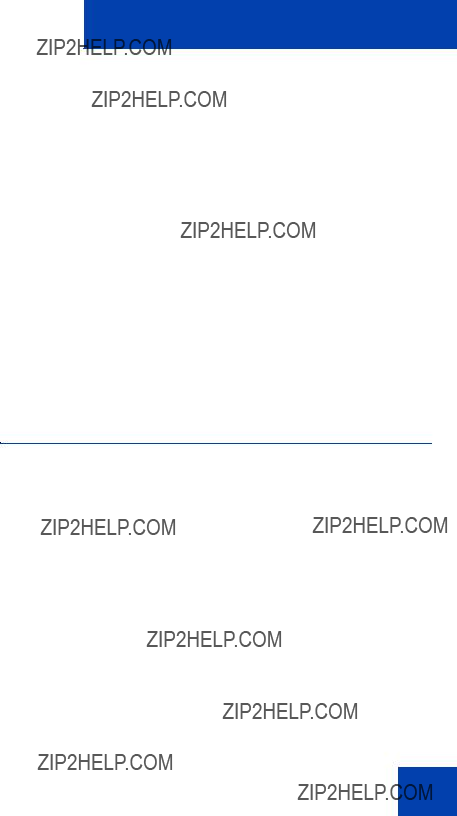
Welcome
Welcome
Your Nortel IP Phone 1210 brings voice and data to your desktop. IP Phone 1210 can directly connect to a Local Area Network (LAN) through an Ethernet connection.
This guide contains the following topics:
??????Using your IP Phone 1210??? on page 23
??????Installing your IP Phone 1210??? on page 30
??????Customizing your IP Phone
??????Customizing your IP Phone
??????Operating your IP Phone 1210??? on page 63
??????Troubleshooting your IP Phone 1210??? on page 104
In this guide,
Feature overview
Your IP Phone 1210 supports the following features:
???four
Note:
???six
-Hold
-Goodbye
-Mute
-Headset
-Handsfree
???three specialized feature keys:
9

Welcome
-Conference
-Services
-Applications
???
???LCD display screen
???
???volume control keys to adjust the ringer, speaker, handset, and headset volume
???hearing aid compatibility
???10/100 Ethernet ports
-one Ethernet port for LAN connection
-one Ethernet port for optional PC connection
???Power over Ethernet (POE) or power through a supported AC adapter
???support to Network Diagnostic Utility
???Accessory Expansion Module (AEM) port to connect the Expansion Module
Figure 1 on page 11 shows an IP Phone 1210.
10
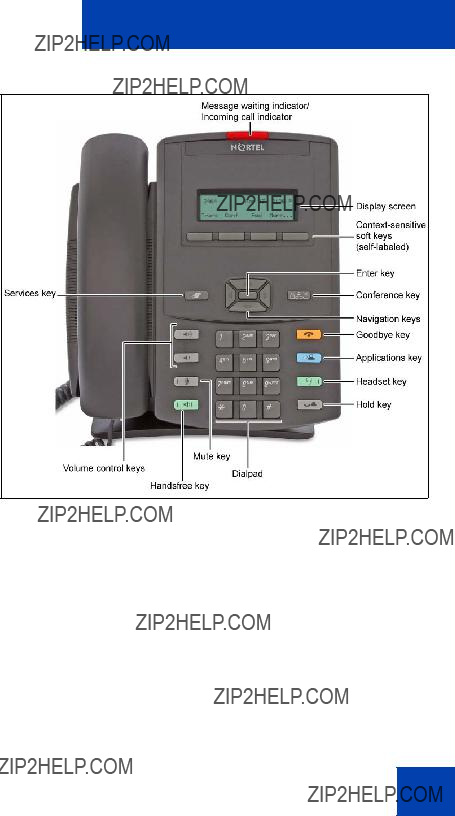
Welcome
Figure 1: IP Phone 1210
11

Regulatory and safety information
Regulatory and safety information
This equipment has been tested and complies with the limits for a Class B digital device, pursuant to part 15 of the FCC Rules. These limits provide reasonable protection against harmful interference in a residential installation.
This equipment generates, uses, and can radiate radio frequency energy and, if not installed and used according to the instructions, can cause harmful interference to radio communications. However, there is no guarantee that interference cannot occur in a particular installation. If this equipment causes harmful interference to radio or television reception, which you can determine by turning the equipment off and on, you are encouraged to try to correct the interference by performing one or more of the following measures:
???Reorient or relocate the receiving antenna.
???Increase the distance between the equipment and receiver.
???Connect the equipment into an outlet on a circuit different from that to which the receiver is connected.
???Consult the dealer or an experienced technician for help.
This Class B digital apparatus complies with Canadian
Warnings
???This is a Class B product. In a domestic environment this product can cause radio interference; in which case, you must take adequate measures.
???Operation is subject to the following two conditions: (1) this device cannot cause interference, and (2) this device must accept interference, including interference that can cause undesired operation of the device.
12

Regulatory and safety information
Other Safety Approvals: IEC
Table 1 on page 13 shows the EMC compliance for various jurisdictions.
Table 1: EMC compliance for various jurisdictions (Part 1 of 2)
13

Regulatory and safety information
Table 1: EMC compliance for various jurisdictions (Part 2 of 2)
Table on page 14 shows the Safety compliance for various jurisdictions.
Table 2: Safety compliance for various jurisdictions (Part 1 of 2)
14

Regulatory and safety information
Table 2: Safety compliance for various jurisdictions (Part 2 of 2)
Other Safety Approvals: IEC
Other
US/Canada: Hearing Aid Compatibility (HAC) as per FCC Part 68
This equipment complies with the CE Marking requirements. 

Australia: AS/ACIF S004: Voice Frequency Performance Requirements for Customer Equipment
EU Countries: This device complies with the essential requirements and other relevant provisions of Directive 1999/5/EC. You can obtain a copy of the Declaration from www.nortel.com/corporate/community/ environment/life_cycle/declarations.html or Nortel Networks GmbH address: Ingolstaedter Strasse
Table 3: EMC compliance (Part 1 of 2)
15

Regulatory and safety information
Table 3: EMC compliance (Part 2 of 2)
Note: This equipment has been tested and found to comply with the limits for a Class A digital device, pursuant to Part 15 of the FCC Rules. These limits are designed to provide reasonable protection against harmful interference when the equipment is operated in a commercial environment. This equipment generates, uses, and can radiate radio frequency energy and, if not installed and used in accordance with the instruction manual, may cause harmful interference to radio communications. Operation of this equipment in a residential area is likely to cause harmful interference in which case the user will be required to correct the interference at his own expense.
The user should not make changes or modifications not expressly approved by Nortel Networks. Any such changes could void the user???s authority to operate the equipment
???Reorient or relocate the receiving antenna.
???Increase the separation between the equipment and receiver.
16

Regulatory and safety information
???Connect the equipment into an outlet on a circuit different from that to which the receiver is connected.
???Consult the dealer or an experienced radio/ TV technician for help.
Note: The user should not make changes or modifications not expressly approved by Nortel Networks. Any such changes could void the user???s authority to operate the equipment
This Class A digital apparatus complies with Canadian
Warnings:
???This is a Class A product. In a domestic environment this product can cause radio interference in which case the user must take adequate measures.
???Operation is subject to the following two conditions: (1) this device may not cause interference, and (2) this device must accept any interference, including interference that may cause undesired operation of the device.
???Privacy of communications may not be ensured when using this telephone.
???Use the following procedure to prevent radio interference to the licensed service, this device must be operated indoors only and should be kept away from windows to provide maximum shielding.
Table 4: Safety standards
17

Regulatory and safety information
Other
US/Canada: Hearing Aid Compatibility (HAC) as per FCC Part 68 This equipment complies with the CE Marking requirements.
EU Countries: This device complies with the essential requirements and other relevant provisions of Directive 1999/5/EC. A copy of the Declaration may be obtained from Nortel Networks GmbH address: Ingolstaedter Strasse
DenAn regulatory notice for Japan
Connecting Power
Use only
18

Regulatory and safety information
Connecting to the Local Area Network
Severe damage to your IP Phone can occur if you plug the phone into an ISDN connection. Consult your system administrator to ensure you plug your IP Phone 1210 into a 10/100 BaseT Ethernet jack.
Operation
The earpiece and mouthpiece of the handset can attract and retain small objects.
Location
Nortel recommends that you install your IP Phone 1210 away from direct sunlight.
19

How to get help
How to get help
This section explains how to get help for Nortel products and services.
Getting Help from the Nortel Web site
The best way to get technical support for Nortel products is from the Nortel Technical Support Web site:
This site provides quick access to software, documentation, bulletins, and tools to address issues with Nortel products. More specifically, you can:
???download software, documentation, and product bulletins
???search the Technical Support Web site and the Nortel Knowledge Base for answers to technical issues
???sign up for automatic notification of new software and documentation for Nortel equipment
???open and manage technical support cases
Getting Help over the phone from a Nortel Solutions Center
If you do not find the required information on the Nortel Technical Support Web site, and you have a Nortel support contract, you can obtain help over the phone from a Nortel Solutions Center.
In North America, call
Outside North America, to obtain the phone number for your region go to
Getting Help from a specialist by using an Express Routing Code
Use the following procedure to access some Nortel Technical Solutions Centers, you can use an Express Routing Code (ERC).Your call is routed to a specialist in your Nortel product or service. Use the following procedure to locate the ERC for your product or service, go to
20

How to get help
Getting Help through a Nortel distributor or reseller
If you purchase the service contract for your Nortel product from a distributor or an authorized reseller, contact the technical support staff of the distributor or reseller.
21

How to get help
22

Using your IP Phone 1210
Using your IP Phone 1210
After you familiarize yourself with the IP Phone 1210 features, you can start to use the phone. This section describes how to use the
IP Phone 1210.
Getting started
The following section introduces the important details of the
IP Phone 1210. Carefully read every section before you operate the new IP Phone 1210.
??????Before you begin??? on page 23
??????IP Phone 1210 display??? on page 24
??????IP Phone 1210 controls??? on page 24
??????Installing your IP Phone 1210??? on page 30
Before you begin
Take the appropriate precautionary measures before you connect the IP Phone 1210.
CAUTION
Consult your system administrator to ensure that you plug your IP Phone into a 10/100BaseT Ethernet jack. To avoid severe damage to your IP Phone, do not plug your IP Phone 1210 into a regular phone jack.
CAUTION
Use your IP Phone 1210 in an indoor environment only.
23
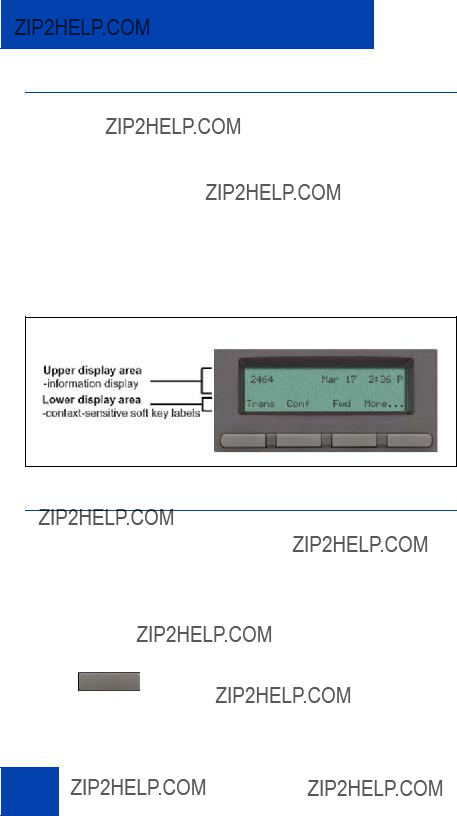
Using your IP Phone 1210
IP Phone 1210 display
Your IP Phone 1210 display is divided into two display areas:
???The upper display area is for information such as caller number, caller name, feature prompt string,
???The lower display area provides labels for the four
Figure 2 on page 24 shows the IP Phone 1210 LCD display screen.
Figure 2: IP Phone 1210 display
IP Phone 1210 controls
This section describes the controls on the IP Phone 1210. Depending on your geographic region, the IP Phone 1210 includes key caps with English text labels. In this document, text in parentheses indicates the labels that appear on the key caps, for example, (Services).
24
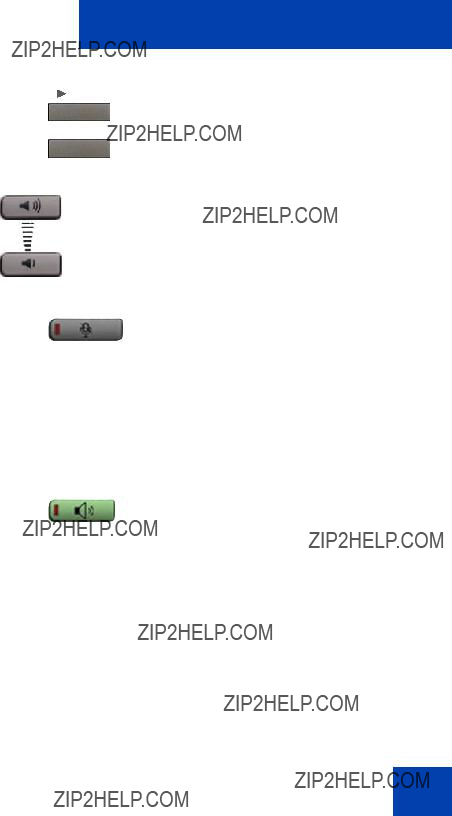
Using your IP Phone 1210
Fwd
More..
(Volume +)
(Volume
(Mute)
(Handsfree)
A triangle before a soft key label, indicates the feature is active.
Press the More key to access the next layer of
Use the Volume control buttons to adjust the volume of the ringer, handset, headset, speaker, and Handsfree features. Press the upper button to increase the volume, and press the lower button to decrease the volume.
Press the Mute key to listen to the calling party without transmitting voice from your phone. Press the Mute key again to return to a
The Mute indicator LED, embedded in the Mute key, flashes to indicate the sound is muted.
Press the Handsfree key to activate handsfree mode.
Note: The Handsfree LED indicator, located on the Handsfree key, lights to indicate that the handsfree is in use.
25
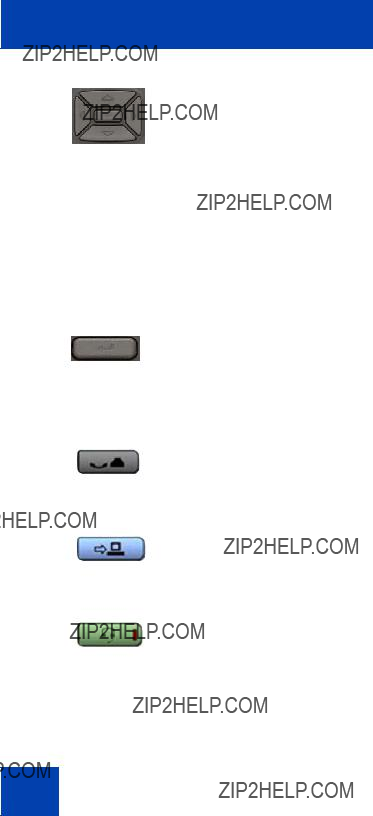
Using your IP Phone 1210
(Hold)
(Applications)
(Headset)
Use the Navigation keys to scroll through menus and lists that appear on the LCD screen. The outer part of this key cluster is used for up, down, left, and right movements.
Use the Up and Down keys to scroll up and down the menu, and the Left and Right keys to position the cursor. In some dialog boxes that appear on your phone, you can also use the Left and Right keys to select editable fields. Press the Right key to select the field below the current selection, or the Left key to select the field above the current selection.
Press the Enter key, at the center of the Navigation key cluster, to confirm menu selections.
In most menus, you can use the Enter key instead of the Select or OK soft key.
Press the Hold key to place an active call on hold. Press the Hold key again to return to the caller on hold.
Press the Applications key to access external server applications.
Press the Headset key to answer a call using the headset or to switch a call from the handset or handsfree to the headset.
Note: The Headset LED indicator, located on the Headset key, lights to indicate that the headset is in use.
26
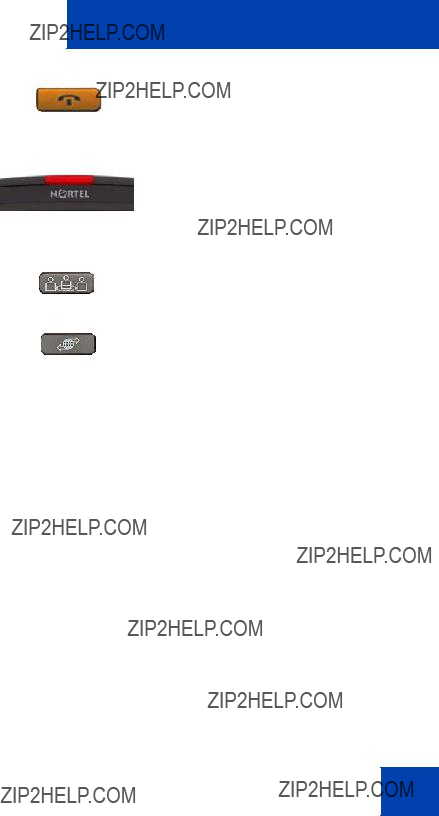
Using your IP Phone 1210
(Goodbye)
(Services)
Press the Goodbye key to terminate an active call.
When a message is waiting, the red Visual Alerter/Message Waiting indicator LED at the top center of the phone flashes. The indicator also flashes to indicate an incoming call. Each alert has a unique flash cadence.
Press the Conference Key to initiate conference.
Press the Services key and use the navigation keys to access the following items:
???Telephone Options
???Volume adjustment
???Contrast adjustment
???Language
???Date/Time
???Display diagnostics
???Local Dialpad Tone
???Set Info
???Diagnostics
27

Using your IP Phone 1210
(Services)
(continued)
(Services)
???Ring type
???Call Timer
???
???Change Feature Key Label
???Live Dialpad
???Password Admin
???Station Control Password
Note: The Password Admin menu is not available on all IP Phone 1210 sets. Consult your system administrator.
???Display Network Diagnostics Utilities
Only your system administrator
or service provider can use Display Network Diagnostics Utilities to perform Internet diagnostics.
???Virtual Office Login and Virtual Office Logout (if Virtual Office is configured)
Press the Services key twice to access the Local Tools menu, and use the navigation keys to access the following items:
???Preferences
???Local Diagnostics
???Network Configuration
???Lock Menu
Note 1: Access to these local options can be password protected. If you press the Services key twice and a password prompt appears, contact your system administrator.
28

Using your IP Phone 1210
Note 2: Press the Cancel context sensitive soft key to exit from any menu or menu item.
Call features and Flexible Feature Codes
Some features are not available on all telephones. Call features and Flexible Feature Codes (FFCs) must be assigned to your telephone and supported by system software. Contact your system administrator to configure these features and codes on your telephone.
Note: Use table ???Flexible Feature Codes??? on page 107 to record the FFCs that your system administrator assigns to your phone.
29
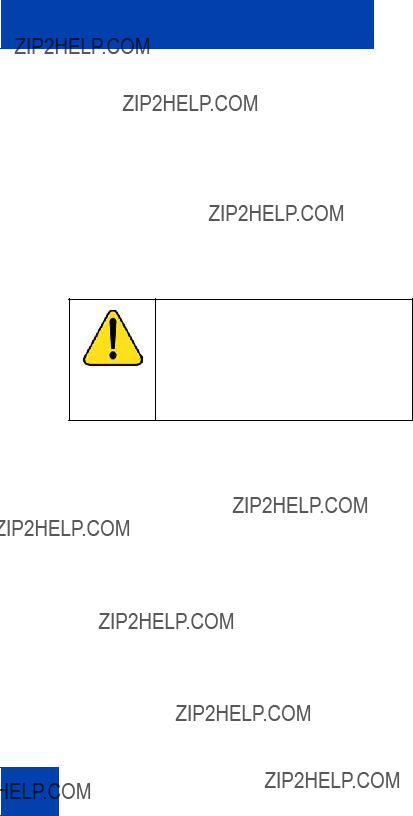
Installing your IP Phone 1210
Installing your IP Phone 1210
This section details the steps and precautionary measures to perform during IP Phone installation. The standard IP Phone 1210 package includes the following accessories:
???foot stand
???handset
???handset cord
???2.1 m (7 ft) CAT5 Ethernet cable
???number plate and lens
CAUTION
Ensure that the protective rubber cap on the Accessory Expansion Module (AEM) port is in place when the port is not in use. An improper connector can damage the IP Phone. Consult your system administrator for additional details.
Figure 3 on page 31 displays the connections on an IP Phone 1210.
30
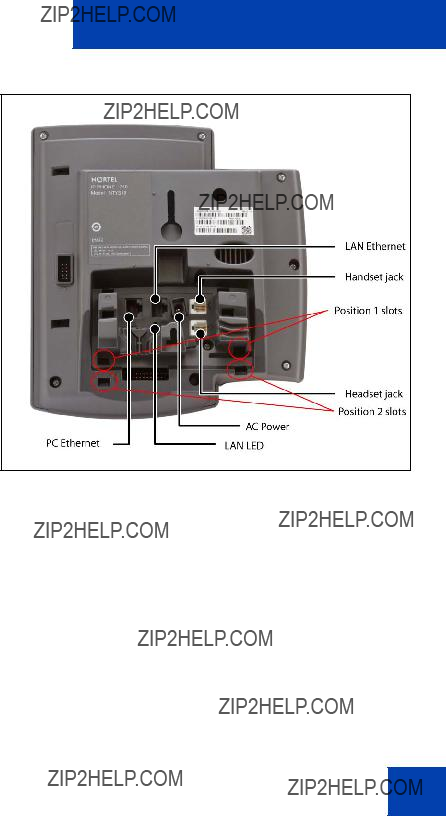
Installing your IP Phone 1210
Figure 3: Connections on the IP Phone 1210
Perform the following steps to connect the components of the phone and to install the phone.
??????Attaching the foot stand (optional)??? on page 32
??????Connecting the handset??? on page 32
??????Connecting the headset (optional)??? on page 32
??????Connecting the power (optional)??? on page 33
??????Connecting the LAN Ethernet cable??? on page 34
31

Installing your IP Phone 1210
Attaching the foot stand (optional)
Attach the foot stand in the appropriate slots depending on the desired angle for your IP Phone. If you insert the foot stand into the upper slots, your IP Phone sits at a
If you install your IP Phone on a wall, do not attach the foot stand.
1.Align the bottom tabs on the foot stand with the position 1 slots or the position 2 slots on the back of your IP Phone.
In position 1 the IP Phone sits at a
Figure 3 on page 31 shows the slots on the back of the IP Phone.
2.Press the foot stand into the slots until it snaps into place.
Connecting the handset
Use the following procedure to connect the handset to the IP Phone.
1.Plug the end of the handset cord with the short straight section into the handset.
2.Plug the other end of the handset cord with the long straight section into the handset jack marked with the + symbol on the back of the IP Phone.
3.(Optional) Thread the cord through the channel in the foot stand (if installed) so that it exits on the side of the foot stand.
Figure 3 on page 31 shows the connections on the back of the IP Phone.
Connecting the headset (optional)
If you have a headset, you can connect the headset to the IP Phone. For information on how to use your headset with your IP Phone, see the IP Phone 1200 Series User Guide
32
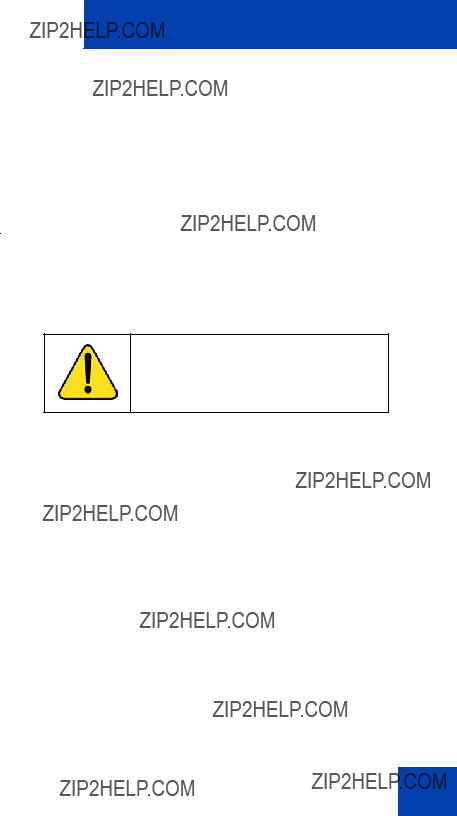
Installing your IP Phone 1210
1.Plug the headset cord into the headset jack on the back of the IP Phone marked with the ) symbol.
Figure 3 on page 31 shows the connections on the back of the IP Phone.
2.Thread the cord through the channel in the side of the foot stand.
3.Set up the headset according to the headset instructions.
Connecting the power (optional)
Your IP Phone supports AC power and Power over Ethernet (PoE). For AC power, use only the
CAUTION
Use your IP Phone 1210 with the approved Nortel AC Adapter (model #N0089601).
Note: Your IP Phone 1210 supports AC power and PoE options, including IEEE 802.3 standard power. To use local AC power, you can order the optional AC adapter separately. To use PoE, where power is delivered over the CAT5 cable, the LAN must support PoE, and you do not require an AC adapter.
1.Connect the DC barrel connector to the power jack on the back of the IP Phone.
2.Thread the cable through the channel in the foot stand to secure the cable.
3.Plug the
33
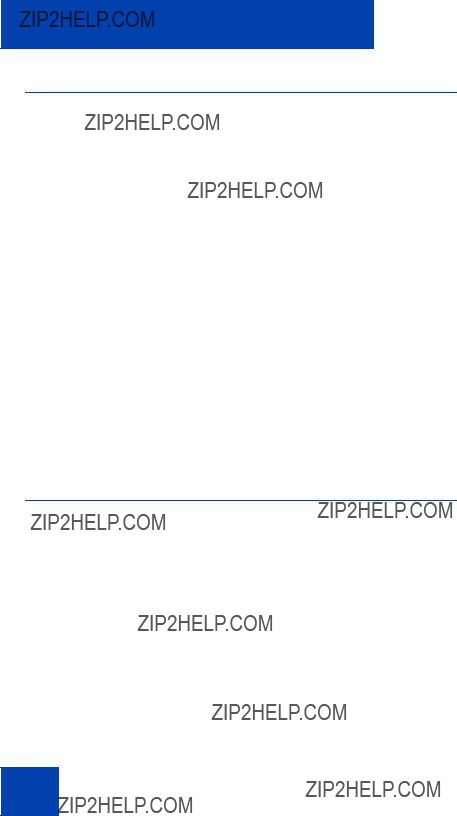
Installing your IP Phone 1210
Connecting the LAN Ethernet cable
Note: Your IP Phone 1210 supports both AC power and PoE options, including IEEE 802.3 standard power. To use local AC power, you can order separately the optional AC adapter. To use PoE, where power is delivered over the CAT5 cable, the LAN must support PoE, and you do not need an AC adapter.
Connect your IP Phone to your LAN using a CAT5e Ethernet cable to enable full functionality of your IP Phone. If your Ethernet port is equipped with Power over Ethernet (PoE), your IP Phone can be powered through the LAN port. Do not extend the LAN Ethernet cable outside the building.
1.Plug one end of the supplied LAN Ethernet cable into the LAN Ethernet port on the back of your IP Phone marked with the % symbol.
2.Thread the cable through the channel in the foot stand.
3.Connect the other end of the cable to your LAN Ethernet connection. The LAN LED on the back of the IP Phone lights when a LAN connection is established.
Figure 3 on page 31 shows the connections on the back of the IP Phone.
Connecting the PC Ethernet cable
Connect the CAT5e PC Ethernet cable between your IP Phone and your computer to enable your computer to access the LAN.
1.Plug one end of the PC Ethernet cable (not supplied) into the PC Ethernet port on the back of your IP Phone marked with the ( symbol.
2.Thread the cable through the channel in the foot stand.
3.Connect the other end of the cable to the LAN port on your computer.
34
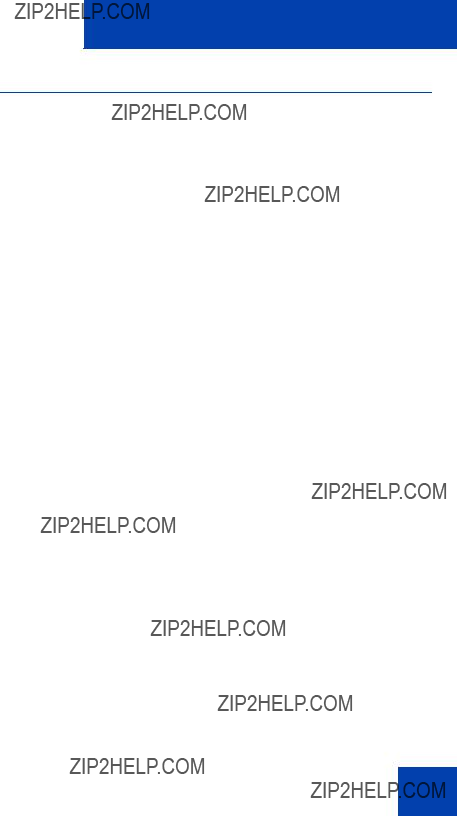
Installing your IP Phone 1210
You can install your IP Phone on a wall.
1.Remove the foot stand.
2.Ensure all cables are properly routed and the IP Phone is functioning.
3.Make small marks on the wall where you want to align each keyhole slot.
4.Insert the screws (not provided) so that they protrude slightly from the wall.
5.Align the keyholes on the back of the IP Phone with the screws in the wall.
6.Slide the IP Phone onto the screws to secure the IP Phone in position.
35

Customizing your IP Phone
Customizing your
IP Phone
This section explains how you can customize the features on your IP Phone 1210 to meet your requirements.
Note: Call features and Flexible Feature Codes (FFC) must be assigned to your IP Phone and supported by system software. Contact your system administrator to configure these features and codes on your IP Phone.
Your IP Phone 1210 has both
???Telephone Options
You can use the Telephone Options menu to configure telephone preferences. For more information, see ???Telephone Options??? on page 36.
???Password Admin
You can use the Password Admin menu to assign or modify the Station Control Password. For more information, see ???Managing your Station Control Password??? on page 50
???Virtual Office Login
The Virtual Office Login menu is available on the IP Phone 1210. You must configure the Class of Service for Virtual Office.
Note: The Password Admin, Virtual Office Login, and Test Local Mode menus are not available on all IP Phone 1210 phones. Consult your system administrator.
Telephone Options
The Telephone Options menu item provides you with access to the following features on your IP Phone 1210:
36

Customizing your IP Phone
??????Adjusting volume??? on page 38
??????Adjusting the display screen contrast??? on page 39
??????Selecting a language??? on page 40
??????Selecting date and time format??? on page 41
??????Accessing display diagnostics??? on page 41
??????Selecting a local dialpad tone??? on page 42
??????Viewing IP Phone information??? on page 43
??????Performing diagnostics??? on page 44
??????Selecting a ring type??? on page 45
??????Enabling or disabling Call Timer??? on page 46
??????Enabling OnHook Default Path??? on page 47
??????Configuring Live Dialpad??? on page 47
Note: If a menu includes a submenu, an ellipsis (...) appears after the command.
Use the following procedure to use the Telephone Options menu.
1. Press the Services key.
(Services)
2.Press the up or down keys to scroll and select Telephone Options.
3. Press the Enter key.
4.Press the up or down keys to scroll, and select an option (for example,
Language).
37
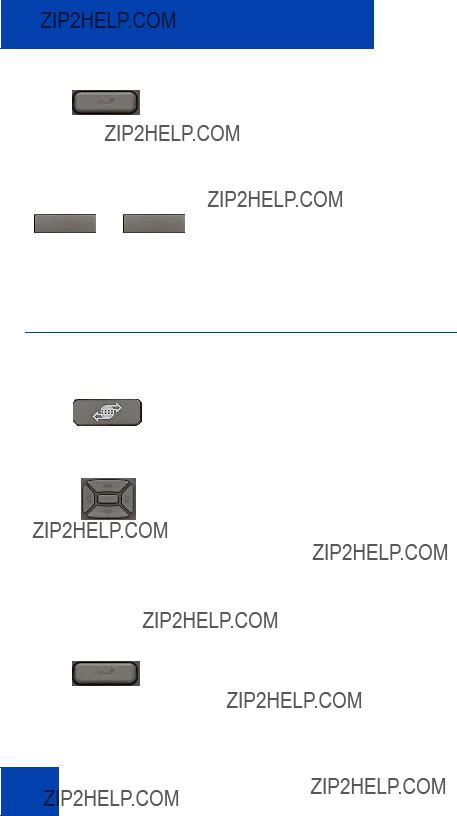
Customizing your IP Phone
5. Press the Enter key. The display provides information required to adjust your selection.
Adjusting volume
Use the following procedure to adjust the volume.
1.Press the Services key, select
Telephone Options, and select Volume adjustment.
2.Press the up or down keys to scroll, and select one of the following:
???Ringer
???Handset listen
???Handsfree listen
???Headset listen
???Buzzer
3. Press the Enter key.
38
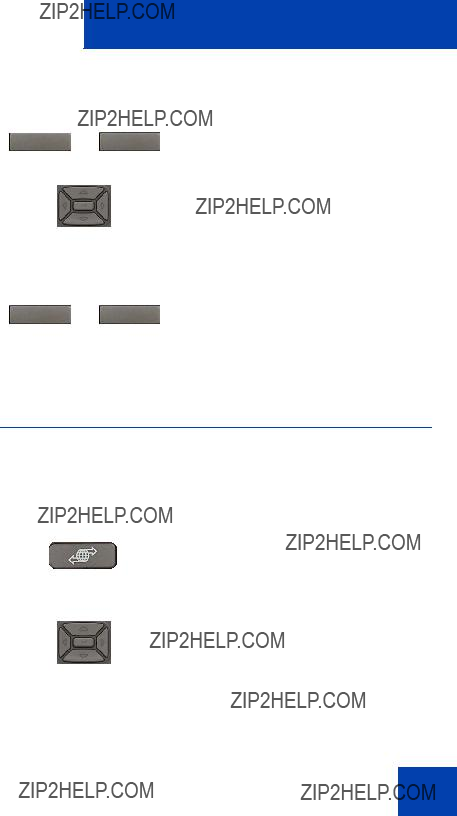
Customizing your IP Phone
Up Down
or
or
Select Cancel
or
4.Press the Up or Down soft keys to increase or decrease the volume.
or
Press the up or down keys.
5.Press the Select soft key to save the volume level and return to the
Telephone Options menu.
or
Press the Cancel soft key to cancel the modifications.
Adjusting the display screen contrast
You can adjust the contrast using the Local Tools menu. Nortel recommends that you use the Telephone Options menu.
Use the following procedure to adjust the display screen contrast.
1.Press the Services key, select
Telephone Options, and select
Contrast adjustment
or
2.To increase or decrease the display contrast level, press the left or right keys.
39
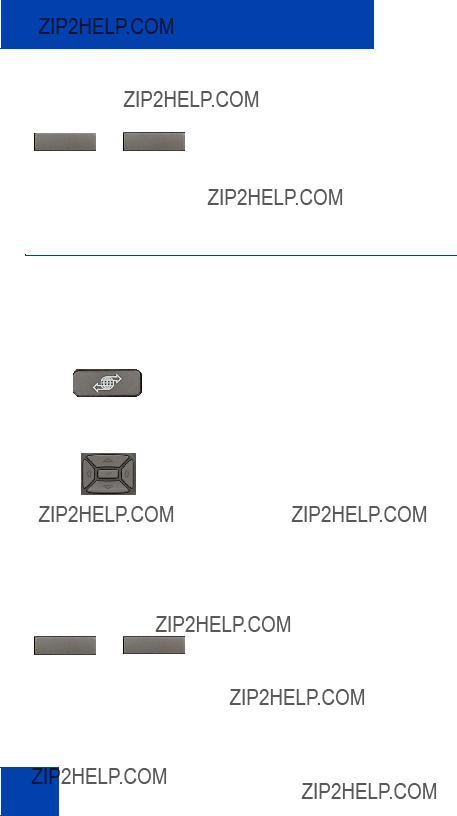
Customizing your IP Phone
3. Press the Select soft key to save the
Select Cancel changes and return to the Telephone Options menu.
or
or
Press the Cancel soft key to cancel the modifications.
Selecting a language
Information that appears on the display is available in multiple languages. This language setting controls the language only for phone features.
Use the following procedure to configure the language.
1.Press the Services key, select
Telephone Options, and select
(Services)Language
2. Press the up or down keys to scroll, and
40
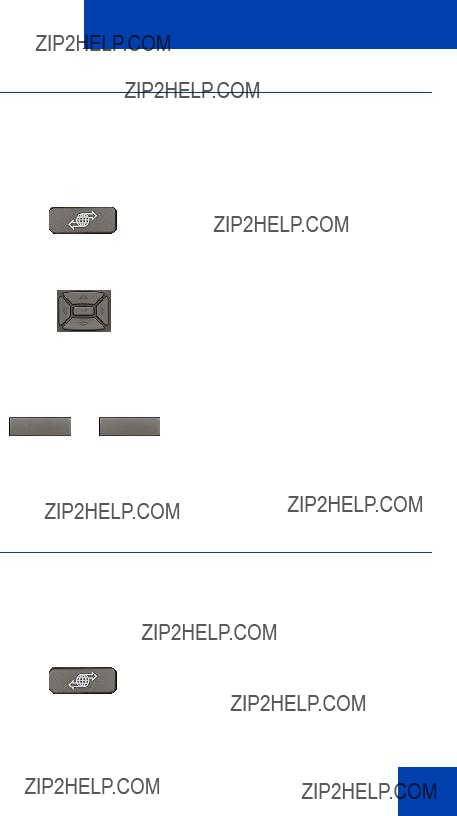
Customizing your IP Phone
Selecting date and time format
Several date and time formats are available. Formats are based on the
Use the following procedure to select a date and time format.
1.Press the Services key, select
Telephone Options, and select Date/
(Services)Time.
2. Press the up or down keys to scroll, and
Accessing display diagnostics
The Display diagnostics command tests the IP Phone display screen and indicator lights.
Use the following procedure to use Display diagnostics.
1.Press the Services key, select
Telephone Options, and select Display
(Services)Diagnostics.
41

Customizing your IP Phone
Selecting a local dialpad tone
When you press a key, the response can be a
Use the following procedure to choose a local dialpad tone.
2.Press the up or down keys to scroll, and select one of the following dialpad tones:
???None to disable all tones.
???Short Click to enable a single tone for all keys.
???DTMF to turn on a different DTMF tone for each key.
42
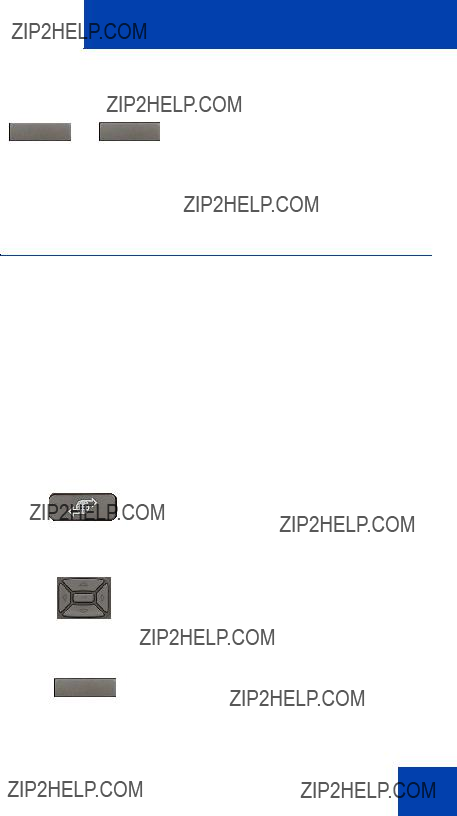
Customizing your IP Phone
Viewing IP Phone information
The Local Set Info option displays the following
???General Info
???Set IP Info
???Ethernet Info
???Server Info
???Encryption Info
???Location Info
Use the following procedure to view IP Phone information:
43
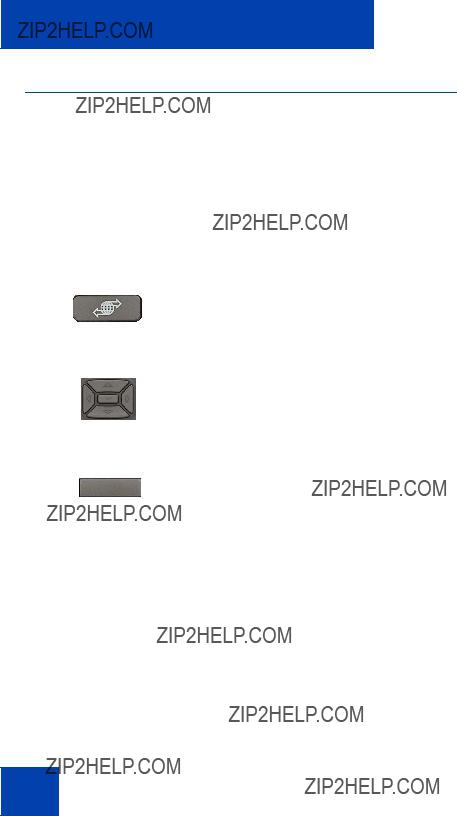
Customizing your IP Phone
Performing diagnostics
The Diagnostics item displays the following
???Diag Tools (Ping, do Route Traces)
???EtherStats (Speed, Auto Neg, CRC Errors, Collision)
???IP Stats (Packet Info)
???RUDP Stats (Message receive or transmit)
???QoS Stats
Use the following procedure to view diagnostic information.
1.Press the Services key, select
Telephone Options, and select Local
(Services)Diagnostics.
2.Press the up or down keys to scroll through the list of diagnostic information.
44
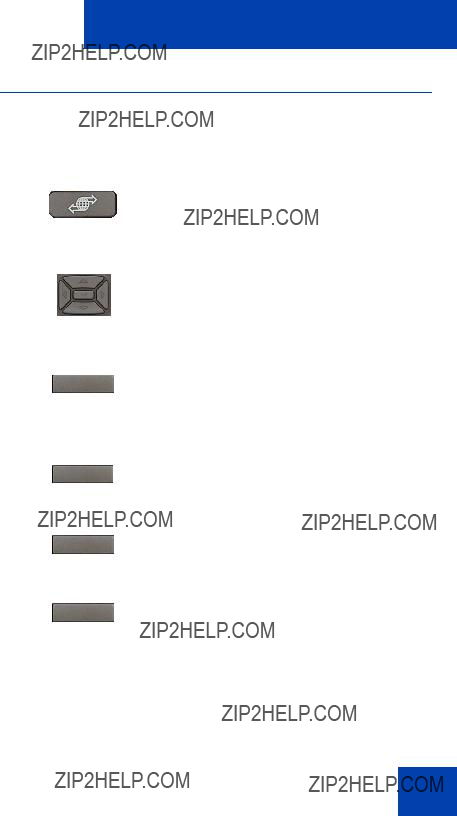
Customizing your IP Phone
Selecting a ring type
Use the Ring type option to configure the IP Phone ring tone.
Use the following procedure to select a ring type:
1.Press the Services key, select
Telephone Options, and select Ring
(Services)type.
Play
Select
Stop
Cancel
2.Press the up or down keys to scroll, and select one of the ring types.
3.Press the Play soft key to sample the ring tone.
4.Press the Select soft key to save the ring type and return to the Telephone Options menu.
or
Press the Stop soft key and use the
up or down keys to select a different ring type.
or
Press the Cancel soft key to cancel the modifications.
45

Customizing your IP Phone
Enabling or disabling Call Timer
The call timer measures the call duration.
Use the following procedure to enable or disable Call Timer.
1.Press the Services key, select
Telephone Options, and select Call
(Services)Timer.
2.Press the up or down keys to enable or disable the Call Timer.
3.Press the Select soft key to save the
46

Customizing your IP Phone
Enabling OnHook Default Path
Use OnHook Default Path option to choose either the Headset or the Handsfree to operate your IP Phone.
Use the following procedure to enable OnHook Default Path.
(Services)
Select Cancel
or
1.Press the Services key, select
Telephone Options, and select On
Hook default path.
2.Press the up or down keys to select one of the following:
???Handsfree Enabled
???Headset Enabled
3.Press the Select soft key to save the default path and return to the Telephone Options menu.
or
Press the Cancel soft key to cancel the modifications.
Configuring Live Dialpad
The Live Dialpad option activates the Primary DN key when you make a call by dialing a directory number on the dialpad without picking up the handset or pressing the Handsfree key.
47
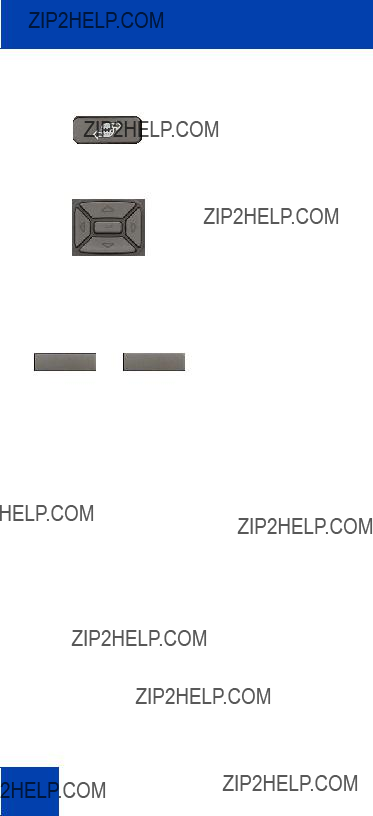
Customizing your IP Phone
Use the following procedure to configure Live Dialpad.
(Services)
Select Cancel
or
1.Press the Services key, select
Telephone Options, and select Live
Dial Pad.
2.Press the up or down keys to scroll, and select one of the following:
???On
???Off (default)
3.Press the Select soft key to save the configuration.
or
Press the Cancel to cancel the modifications.
48
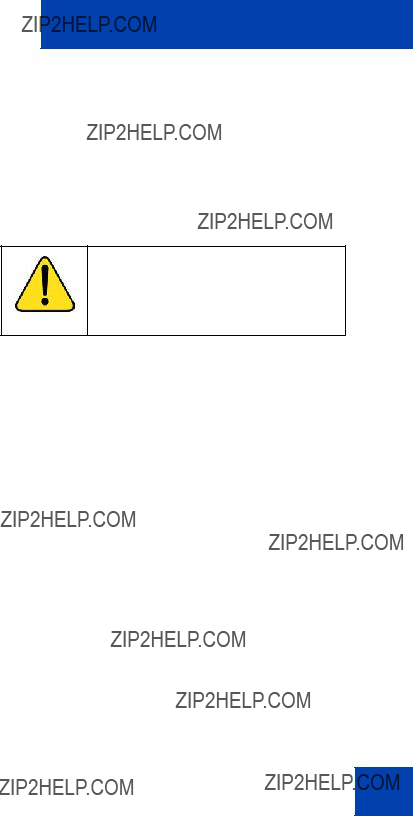
Customizing your IP Phone
Customizing your
IP Phone
You can customize features on your IP Phone 1210 to meet your requirements. This section describes how to customize the advanced features.
CAUTION
Many of the options discussed in this section are for the system administrator only. Do not make changes unless you are instructed by an administrator.
You and the system administrator can customize the following advanced features:
???Password Admin
Use the Password Admin menu to assign or modify the Station Control Password. See ???Managing your Station Control Password??? on page 50.
???Electronic Lock
Assign a lock on your phone to secure your phone and avoid misuse. See ???Configuring an Electronic Lock on your IP Phone??? on page 51.
???Local Tools menu
Use the Local Tools menu to configure personal preferences. See ???Configuring the Local Tools menu??? on page 53.
???Virtual Office Login
The Virtual Office Login menu can be configured on IP Phone 1210. Class of Service must be configured for the Virtual Office. See ???Using Virtual Office??? on page 58.
Note: The Password Admin, and Virtual Office Login menus are not available on all IP Phone 1210 phones. Consult your system administrator.
49

Customizing your IP Phone
Managing your Station Control Password
You can assign a Station Control Password (SCPW) to
???lock your IP Phone and prevent the misuse of your IP Phone
???use
Your system administrator defines your initial SCPW. Contact your system administrator for detailed information.
Assigning an SCPW
Use the following procedure to assign an SCPW.
1. Press the Services key.
(Services)
2.Press the up or down keys to scroll, and select Password Admin.
3.Press the Enter key.
4.Press the up or down keys to scroll, and select New Password.
5.Press the Enter key.
50

Customizing your IP Phone
Configuring an Electronic Lock on your IP Phone
Use the Electronic Lock feature to prevent others from making calls from your IP Phone. Your SCPW controls the Electronic Lock feature. To change your Station Control Password, see ???Managing your Station Control Password??? on page 50.
Locking your IP Phone 1210
Use the following procedure to lock your IP Phone 1210.
1. Lift the handset.
2. Dial the Electronic Lock Activate FFC.
51

Customizing your IP Phone
Unlocking your IP Phone 1210
Use the following procedure to unlock your IP Phone 1210.
1. Lift the handset.
2.Dial the Electronic Lock Deactivate
FFC.
3.Dial your Station Control Password.
52
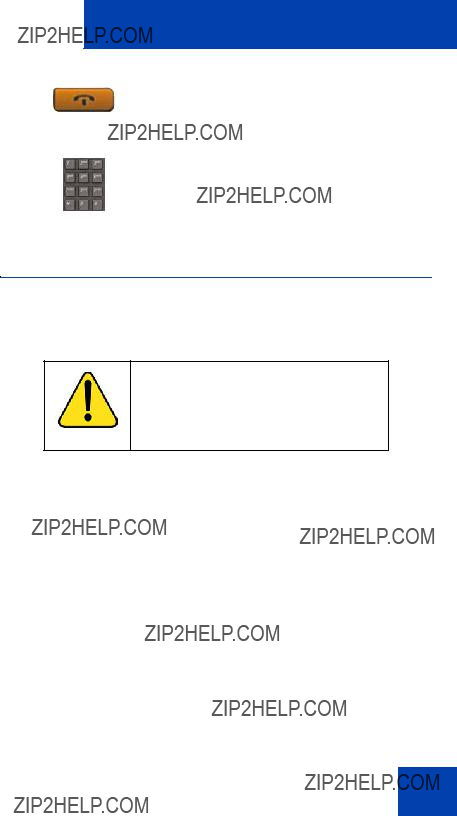
Customizing your IP Phone
Configuring the Local Tools menu
Your IP Phone 1210 has both local and
CAUTION
Many of the options discussed in this section are for administrator use only. Do not make changes unless you are instructed by an administrator.
Note: Your system administrator can establish a password for the Local Tools menu. When the password is enabled, a password prompt dialog box appears when you attempt to access this menu. If this happens, contact your system administrator.
Local tools and features are accessed through the Local Tools menu. Press the Services key twice to access this menu. Your system administrator can establish a password for the Local Tools menu. When the password is enabled, a password prompt appears when you attempt to access this menu. If this occurs, contact your system administrator.
The Local Tools menu provides the following menu options:
??????1. Preferences??? on page 56
53

Customizing your IP Phone
??????4. Lock Menu??? on page 58
If a menu command has a number in front of it, you can select the command by pressing the associated key on the dialpad. For example, in the Local Tools menu, access Local Diagnostics by pressing the 2 key on the dialpad.
The function of some keys on the IP Phone differs based on the situation. Table 5 describes the function of each key for navigating and using menus.
Table 5: Navigation key functions in menus
Table 6 on page 54 describes the key functions in dialog boxes.
Table 6: Navigation key functions in dialog boxes (Part 1 of 2)
54

Customizing your IP Phone
Table 6: Navigation key functions in dialog boxes (Part 2 of 2)
When you work in Edit mode, the first field of the item is selected and a blinking cursor appears to the right of the current edit position. Table 7 on page 55 describes the navigation key functions in Edit mode.
Table 7: Navigation key functions in Edit mode
Note: Special characters are under 1digit key. By repeatedly pressing
1, the characters circle in the following sequence: 1, _,
55

Customizing your IP Phone
1. Preferences
Use the 1.Preferences menu to alter the following local preferences:
??????1. Contrast??? on page 56
??????2. Language??? on page 56
1. Contrast
Use the Contrast tool to alter the physical settings of the display.
Note: Changes made to the display Contrast using this method are lost if you reset the phone. To avoid this situation, Nortel recommends that you use the Contrast Adjustment control in the Telephone Options menu for contrast adjustment.
Use the following procedure to adjust Contrast setting.
(Services)
2. Language
1.Press the Services key twice to open the Local Tools menu, press the 1 key on the dialpad to select Preferences, and press the 1 key to select Contrast.
2.Press the right or left arrow keys to increase or decrease the contrast value.
3.Press the Enter key to save the changes.
Information that appears on the display is available in multiple languages.
56

Customizing your IP Phone
Use the following procedure to select a language
(Services)
Cancel
1.Press the Services key twice to open the Local Tools menu, press the 1 key on the dialpad to select 1.Preferences, and press the 2 key to select
2.Language.
2.Press the up or down keys to scroll, and select the desired language (for example, German [Deutsche]).
3.Press the Enter key to save the changes.
4.Press the Cancel key to exit the Preferences menu without saving the changes.
Note: The language setting only controls the language used in the local menus on your phone. To select the language for features on your phone, press the Services key, select Telephone Options, and select Language???
2. Local Diagnostics
The 2. Local Diagnostics submenu offers the following choices:
???IP Set and DHCP Information - View reports about IP Phone 1210 and DHCP operation.
???Network Diagnostic Tools - Diagnose network problems using ping and trace route tools.
???Ethernet Statistics tool - View reports about Ethernet operation.
???IP Network Statistics - View reports about network operation.
57
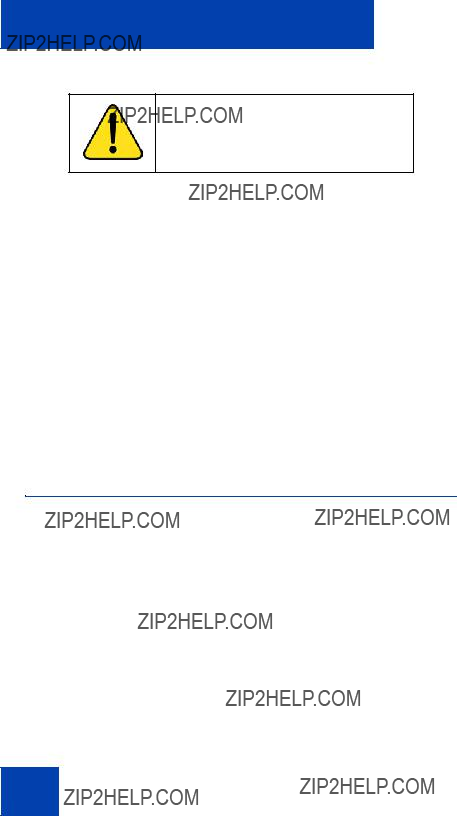
Customizing your IP Phone
CAUTION
Local Diagnostics, Network Configuration, and Lock Menu tools are for the system administrator use only.
Press the Return soft key at any time while you customize the phone using the Local Diagnostics submenu options to return to the previous Local Diagnostics submenu. You can gather information and run tests without exiting and
3. Network Configuration
The Network Configuration tool displays information that was configured when you installed the IP Phone. This tool is for administrator use only.
4. Lock Menu
Your system administrator can use the lock menu tool to protect the Local Tools menu items from accidental or unwanted changes. This tool is for administrator use only.
Using Virtual Office
Use the Virtual Office feature to transfer calls and office IP Phone settings to a remote IP Phone. You can use the remote IP Phone as if it were your office Phone when you are out of the office. You can use another IP Phone (the remote phone) to log on to your Office IP Phone. After you log on, you can access the DNs, and autodial numbers, and you have the same key layout, and voice mail features that are configured on your home or office IP Phone.
Use the following procedure to use Virtual Office, you need your DN and a preconfigured SCPW. You must activate Virtual Office on your Office phone before you can connect to it from a remote phone. See ???Logging in to Virtual Office??? on page 60.
58

Customizing your IP Phone
Consult your system administrator to confirm the availability of the Virtual Office feature on your IP Phone.
The IP Phone used as a remote phone to connect to your IP Phone 1210 need not necessarily be an IP Phone 1210. Table 8 on page 59 shows the IP Phones on which you can use Virtual Office to connect to your
IP Phone 1210.
Table 8: Virtual Office connection availability
59
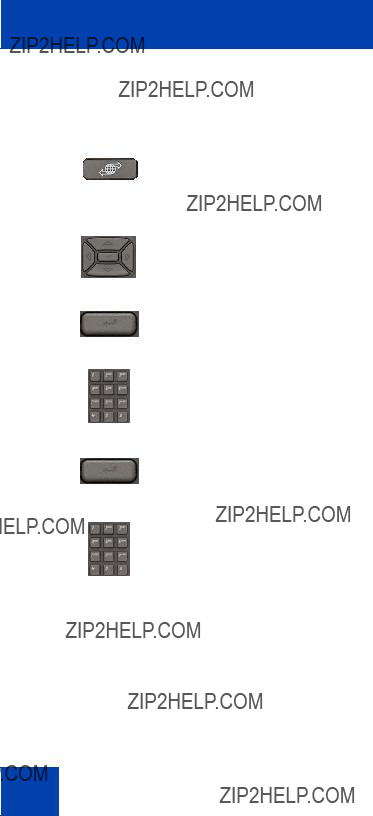
Customizing your IP Phone
Logging in to Virtual Office
Use the following procedure to activate Virtual Office on your Office IP Phone from your Remote IP Phone perform the following steps.
1. Press the Services key.
(Services)
2.Press the up or down keys to scroll, and select Virtual Office Login.
3. Press the Enter key.
4. At the prompt, enter your user ID.
5. Press the Enter key.
6.At the prompt, enter the home Station Control Password (SCPW).
If the user ID is not found locally, the message Locating Remote Server appears.
Note: After three failed logon attempts, wait for an hour before you try to log on again. Alternatively, contact your system administrator to reset your password.
For more information, see ???Assigning an SCPW??? on page 50.
60

Customizing your IP Phone
A successful logon transfers all the features, time, date, and tones of your Office IP Phone to your Remote IP Phone. Your Virtual Office session expires after a fixed period of time, which your system administrator determines.
Using Virtual Office on your remote IP Phone
The display characteristics, including size of the display area, differ with IP Phone models. Your Virtual Office display depends on the remote phone that you use to log on to your Virtual Office. All features are as they appear on your Office IP Phone 1210.
An IP Phone 1120E, that is logged on as a remote phone to an IP Phone 1210 Office phone, provides less information than the IP Phone 1210 because it has fewer display lines.
When an IP Softphone 2050 logs on as a remote phone to an IP Phone 1210 office phone, the information display is arranged differently, but all the information is visible at one time.
Regardless of the IP Phone model that you use as a remote phone, a user information line appears that lists the number of your Office IP Phone.
Using Virtual Office on your office IP Phone
When activated for Virtual Office by a remote IP Phone, your office IP Phone logs off and is no longer operational. When you return to the office, disconnect the remote logon and regain control of your office phone. If you do not explicitly disconnect the remote logon, your Virtual Office session expires after a fixed period of time, which your system administrator determines.
Note: Consult your system administrator to verify if the Virtual Office feature is available for your use.
61

Customizing your IP Phone
Disconnecting your office IP Phone from a remote IP Phone
Use the following procedure to disconnect your office IP Phone from a remote IP Phone.
Home
To disconnect your office IP Phone from the remote IP Phone
a.Press the Home soft key.
b.Enter your User ID and password (this logs on the Office IP Phone to your office network).
or
or
Virtual
Press the Virtual soft key to log on to another IP Phone, and your IP Phone becomes a Remote IP Phone.
Logging out of Virtual Office
While working on a remote phone, you can log out of Virtual Office using the following steps.
1. Press the Services key.
(Services)
2.Press the up or down keys to scroll, and select Virtual Office Logout.
3.Press the Enter key.
62

Operating your IP Phone 1210
Operating your IP Phone 1210
This section describes how to operate your IP Phone 1210. It describes the operations like ???Entering and editing text??? on page 63 and ???Making a call??? on page 64.
Entering and editing text
You can enter and edit text on your IP Phone 1210 using the following methods:
??????Using the telephone dialpad??? on page 63
??????Using the soft keys??? on page 63
Using the telephone dialpad
You can use the dialpad to enter text.
For example, to enter the letter A, press the 2 key once. To enter the letter C, press the 2 key three times.
Note: No letters are associated with the 1 or the 0 keys.
Using the soft keys
You can use soft keys to edit text.
Table 9 on page 63 describes the soft key editing functions on the IP Phone 1210.
Table 9: Editing soft key description (Part 1 of 2)
63
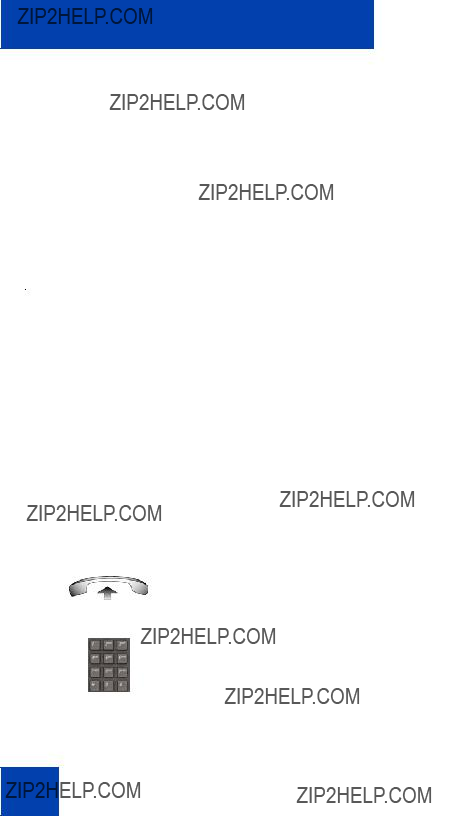
Operating your IP Phone 1210
Table 9: Editing soft key description (Part 2 of 2)
Making a call
This section describes the various ways you can make a call from your IP Phone 1210.
??????Using
??????Using
??????Using Handsfree dialing??? on page 66
??????Using Predial??? on page 68
??????Using Speed Call??? on page 71
??????Using Speed Call??? on page 71
??????Using System Speed Call??? on page 73
Using
Perform the following steps to make a call by using the handset.
1. Lift the handset.
2. Dial the number.
64
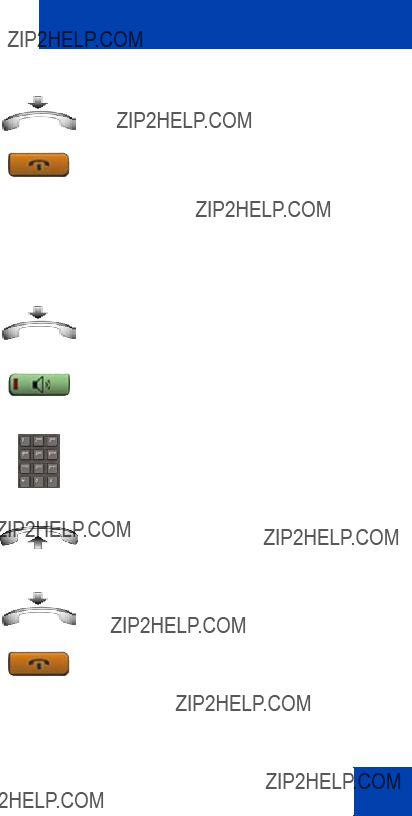
Operating your IP Phone 1210
or
(Goodbye)
3.To terminate the call, return the handset to the cradle
or Press the Goodbye key.
Using
Perform the following steps to make a call without lifting the handset.
or
(Goodbye)
1.Leave the handset in the cradle.
2.Press the Handsfree key.
3.When the dial tone sounds, dial the number.
4.When the called party answers, lift the handset.
5.To terminate the call, return the handset to the cradle
or Press the Goodbye key.
65

Operating your IP Phone 1210
Using Handsfree dialing
Use handsfree dialing to make a call using the
1. Press the Handsfree key.
If a headset is connected, press the
Headset key.
2. Dial the number.
During a call, you can perform the following tasks:
??????Terminating a handsfree call??? on page 66
??????Muting a handsfree call??? on page 67
??????Switching from handsfree to handset mode??? on page 67
??????Switching from handset mode to handsfree??? on page 67
??????Using a headset??? on page 67
??????Switching from handsfree to headset??? on page 68
Terminating a handsfree call
Use the following procedure to terminate a handsfree call.
1. Press the Goodbye key.
(Goodbye)
66
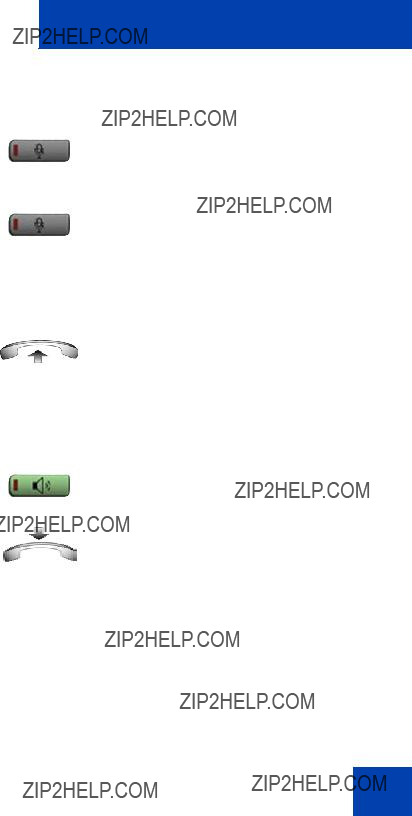
Operating your IP Phone 1210
Muting a handsfree call
Use the following procedure to mute a handsfree call.
(Mute)
(Mute)
1.Press the Mute key.
The LED indicator flashes.
2.Press the Mute key again to return to a
Switching from handsfree to handset mode
Use the following procedure to switch from handsfree to handset mode.
1. Lift the handset.
Switching from handset mode to handsfree
Use the following procedure to switch from handset mode to handsfree.
1. Press the Handsfree key.
2. Replace the handset.
Using a headset
Use the following procedure to use a handset.
1.Connect the headset to the headset jack.
67
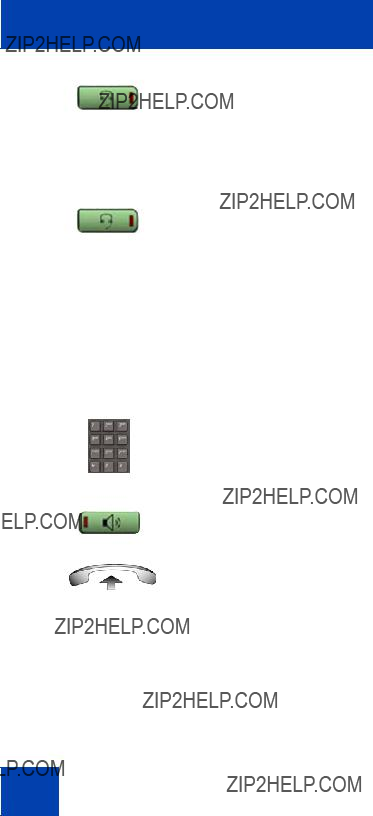
Operating your IP Phone 1210
2. Press the Headset key.
Switching from handsfree to headset
Use the following procedure to switch from handsfree to headset.
1. Press the Headset key.
Using Predial
Use the Predial feature to enter, preview, and edit numbers before you make a call.
Making a call
Use the following procedure to make a call using the Predial feature.
1. Enter the number to be dialed.
2. Press a Handsfree key.
3.Lift the Handset when the called party answers.
or
Begin to speak. You are in handsfree mode.
68
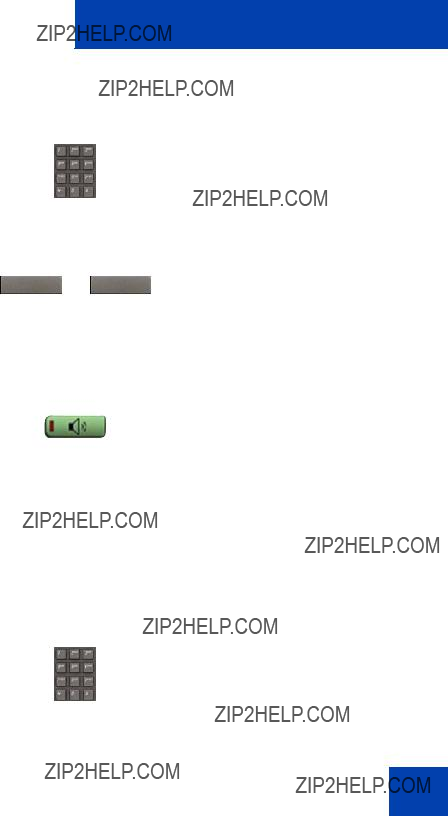
Operating your IP Phone 1210
Editing a Predial number
Use the following procedure to edit a Predial number.
1.Use the dialpad to enter the number.
2.To erase all numbers, press the Clear
To change one number at a time, press the Delete soft key to backspace. Re- enter the number.
3.Press a Handsfree key to dial the number.
Activating Ring Again
Use the Ring Again feature to automatically redial the number if you receive a busy tone, or if your called party does not answer. Your IP Phone rings when the person you called becomes available.
Activating Ring Again
Use the following procedure to activate Ring Again.
1.Dial a number.
The called party does not answer or you receive a busy tone.
69

Operating your IP Phone 1210
Calling a Ring Again party after notification
Use the following procedure to call a Ring Again party after notification.
70

Operating your IP Phone 1210
Deactivating Ring Again before notification
Use the following procedure to deactivate Ring Again.
Ring Again
or
1.Press the Ring Again soft key a second time.
or
Press the Ring Again Deactivate FFC.
Using Speed Call
Use the Speed Call feature to place internal and external calls by dialing a
Storing a Speed Call number
Use the following procedure to store a Speed Call number.
The triangular icon flashes to indicate programming mode.
2.At the prompt, enter a
3.If required, dial the access code.
4.Enter the phone number (internal, external, or
71

Operating your IP Phone 1210
Making a call using Speed Call
Use the following procedure to make a call using Speed Call.
1. Lift the handset.
3.Dial the Speed Call code to automatically dial the number.
72
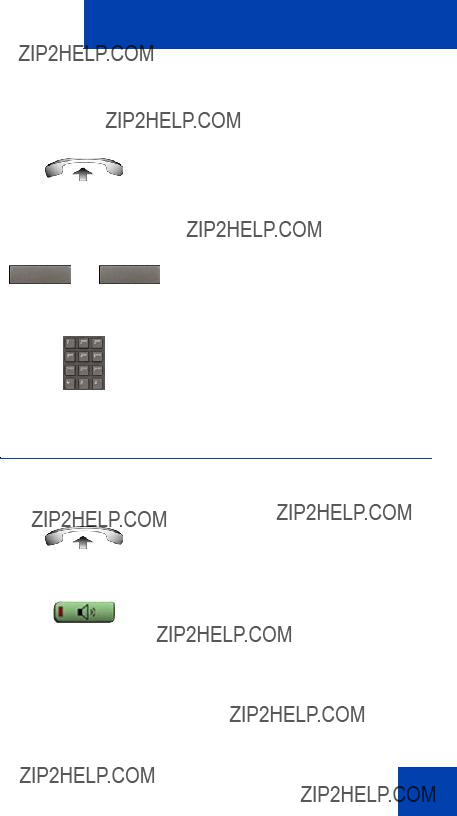
Operating your IP Phone 1210
Using System Speed Call
Use the System Speed Call feature to dial Speed Call codes that override dialing restrictions placed on your IP Phone.
Answering a call
Each incoming call causes the IP Phone to ring, the LCD indicator beside the line (DN) key to flash, and the Message Indicator lamp to flash.
1. Lift the handset.
Press the Handsfree button on the left side of the handset.
or
or
73

Operating your IP Phone 1210
Press the Headset key if a headset is connected to your IP Phone.
Managing calls during a call
You can use the following features during a call:
??????Using Call Hold??? on page 74
??????Using Call Waiting??? on page 75
??????Transferring a call??? on page 76
??????Using Timed Reminder Recall??? on page 77
??????Using Attendant Recall??? on page 78
??????Using Call Park??? on page 79
??????Recording a Calling Party (Caller) Number??? on page 81
??????Displaying call details??? on page 82
Using Call Hold
Use the Hold feature to retain your current call and answer another call. Place the original call on hold and then answer the second call.
Placing a call on hold
Use the following procedure to place a call on hold.
Note: Enabling Automatic Hold automatically places the active call on hold when you answer the second call.
74

Operating your IP Phone 1210
Retrieving a call on hold
Use the following procedure to retrieve a call on hold.
(Hold) or
1.Press the Hold key to place an active call on hold. Press the Hold key again or the press the Handsfree key to return to the caller on hold.
Using Call Waiting
The Call Waiting feature produces a tone to alert you to an incoming call when you are already on a call. Call Waiting also places the current call on hold while you answer the new call.
Answering an call during another call
Use the following procedure to answer a call during another call.
1.Upon receiving a call, press the Hold key to place the current call on hold.
(Hold)
Note: Enabling Automatic Hold automatically puts the active call on hold when you answer the second call.
75

Operating your IP Phone 1210
Returning to the original call
Use the following procedure to return to the original call.
(Hold) or
(Goodbye)
1.Press the Hold key to place the second call on hold.
or
Press the Goodbye key to end the second call.
2. Press the Handsfree key.
Transferring a call
Use the Transfer feature to redirect a call to the appropriate person.
Transferring a call to a third party
Use the following procedure to transfer a call to a third party.
76
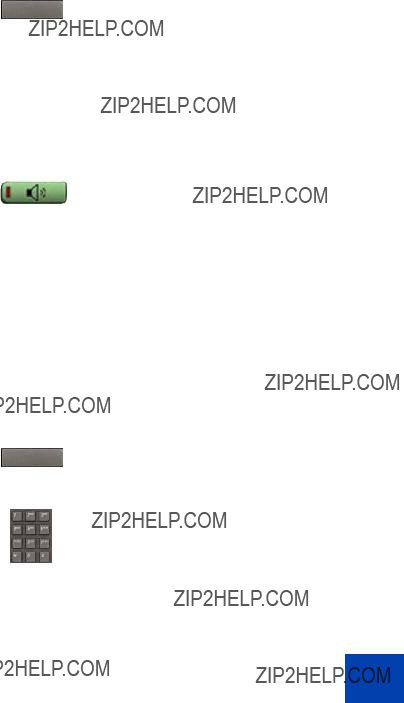
Returning to the original call if the transfer is incomplete
Use the following procedure to return to the original call if the transfer is incomplete.
1.If the called party does not answer the transferred call, press the Handsfree key to reconnect to the calling party.
Using Timed Reminder Recall
Use the Timed Reminder Recall feature to receive an automatic reminder tone when a transferred call is not answered.
Transferring a call using Timed Reminder Recall
Use the following procedure to transfer a call using Timed Reminder Recall.
77

Operating your IP Phone 1210
If the transferred call is not answered, your IP Phone rings.
Returning to the original call if the transferred call is unanswered
Use the following procedure to return to the original call if the transferred call is unanswered.
or
or
If the called party answers, press the Goodbye key to complete the transfer.
(Goodbye)
Using Attendant Recall
Use the Attendant Recall feature to contact an attendant during a call and to connect the caller to the attendant.
78

Operating your IP Phone 1210
Using Call Park
Use the Call Park feature to hold (park) your active call temporarily and retrieve a call from any IP Phone. Using Call Park does not tie up a line.
Parking a call on the System Park DN
To park a call on the System Park DN or your own DN, perform the following procedure.
Note: Enabling System Park DN automatically parks the calls on the system park DN.
Parking a call on a DN (Not System Park DN or own DN)
To park a call on a DN (Not System Park DN or own DN), perform the following procedure.
2. Dial the DN on which to park the call.
79

Operating your IP Phone 1210
Parking a call using the SPRE code or FFC
To park a call using the SPRE code or FFC, perform the following procedure.
Trans Conf
or
Trans Conf
or
1. Press the Trans soft key. or
Press the Conference soft key.
2.Dial the Call Park FFC.
3.To use an alternative DN from the System Park DN or your own DN, dial the DN where you want to park the call. Otherwise, proceed to step 4.
4.Press the Transfer soft key.
or
Press the Conference soft key.
Retrieving a parked call
Use the following step to retrieve a parked call.
80
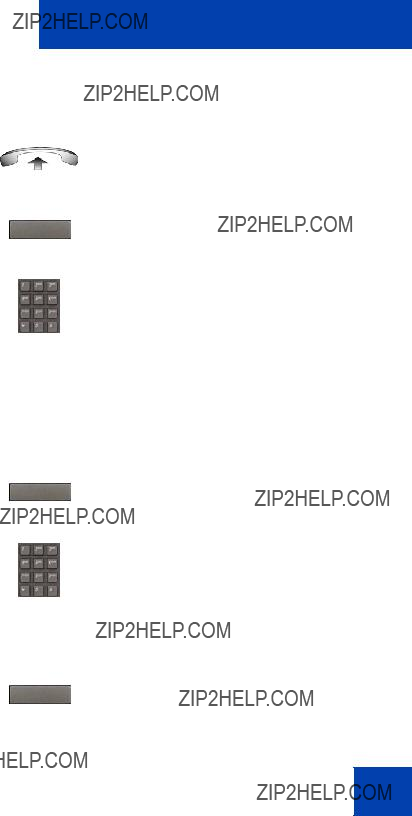
Operating your IP Phone 1210
Note: When Call Park is configured
3.Dial the DN where you parked the call.
If a parked call is not retrieved within a specific time, it rings back to your IP Phone or to the attendant.
Recording a Calling Party (Caller) Number
During a call use the Calling Party Number feature to record the calling party number, or to charge the call to an account number.
81

Operating your IP Phone 1210
Displaying call details
During an active call, use the Display feature to display the caller???s number and name (if available) without interfering with the call.
Managing calls while away from your desk
You can use the following features when you are away from your desk to manage an incoming call and to ensure you do not miss a call:
??????Using Call Forward??? on page 82
??????Using Internal Call Forward??? on page 83
??????Using Remote Call Forward??? on page 85
Using Call Forward
Use the Call Forward feature to direct incoming calls to ring on another line (DN). A call already on your IP Phone cannot be forwarded.
Activating Call Forward
Use the following procedure to activate Call forward or change the call follow number
Fwd.
or
1. Press the Fwd soft key. or
Lift the handset and enter the Call Forward All Calls Activate FFC.
82

Operating your IP Phone 1210
2.Dial the DN to which you want to forward your calls.
Deactivating Call Forward
Use the following procedure to deactivate Call Forward.
Fwd.
or
1. Press the Fwd soft key. or
Lift the handset and enter the Call Forward All Calls Deactivate FFC.
Reinstating a Call Forward number
Use the following procedure to reinstate Call Forward number.
Using Internal Call Forward
Use Internal Call Forward to forward only those calls that originate from internal DNs. Calls that originate outside your IP Phone system (External Calls) ring at your IP Phone. You cannot forward the currently active call.
83
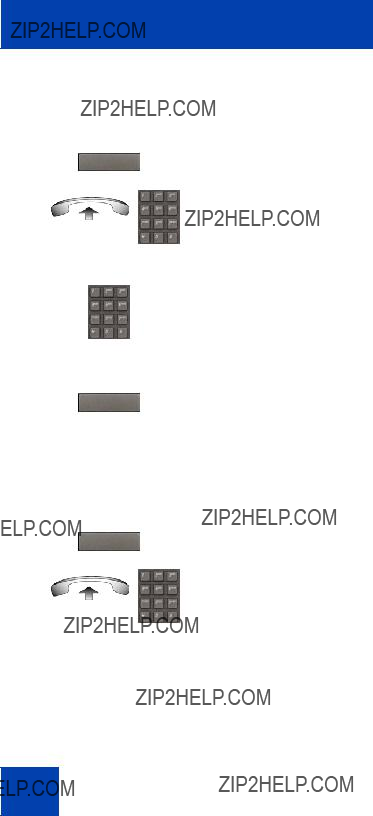
Operating your IP Phone 1210
Forwarding internal calls only
Use the following procedure to forward internal calls only.
or
2.Dial the DN to which you want to forward your internal calls.
Deactivating Internal Call Forward
Use the following procedure to deactivate Internal Call Forward.
or
84

Operating your IP Phone 1210
Reinstating Internal Call Forward number
Use the following procedure to reinstate Internal Call Forward number.
Using Remote Call Forward
Use the Remote Call Forward feature to forward calls on your IP Phone to another from a remote IP Phone.
Activating Remote Call Forward
Use the following procedure to activate Remote Call Forward.
1. Lift the handset.
2.If you call from an IP Phone outside the system, dial your direct system access number and wait for the dial tone.
3.Dial the Remote Call Forward Activate
FFC to activate the feature.
4.Dial your Station Control Password. You hear a dial tone.
85

Operating your IP Phone 1210
5. Dial your DN.
or
To reinstate call forward to the previous orcall forward number, press the # key.
(Do not perform steps 6 and 7.)
6.Dial the number to which to forward the calls.
If the number dialed is invalid, you hear a fast busy signal.
7. Press the # key.
Deactivating Remote Call Forward
Use the following procedure to activate Remote Call Forward.
1. Lift the handset.
2.If you call from an IP Phone outside the system, dial the direct system access number and wait for the dial tone.
3.Dial the Remote Call Forward Deactivate FFC.
86
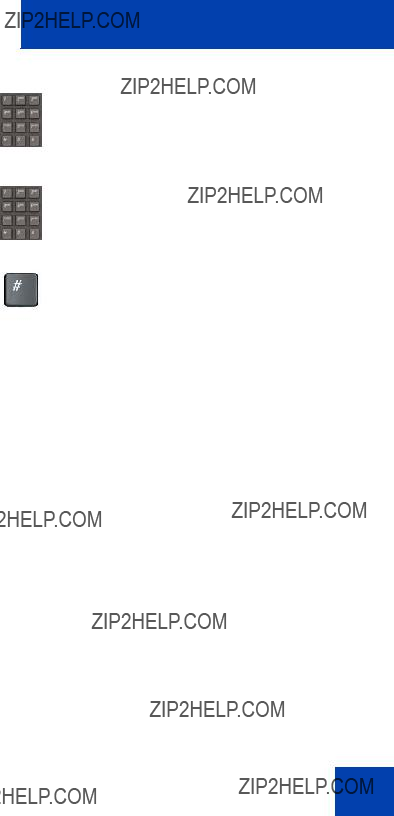
Operating your IP Phone 1210
4.Dial your Station Control Password.
5.After you hear the dial tone, dial your DN.
6.Press the # key.
87
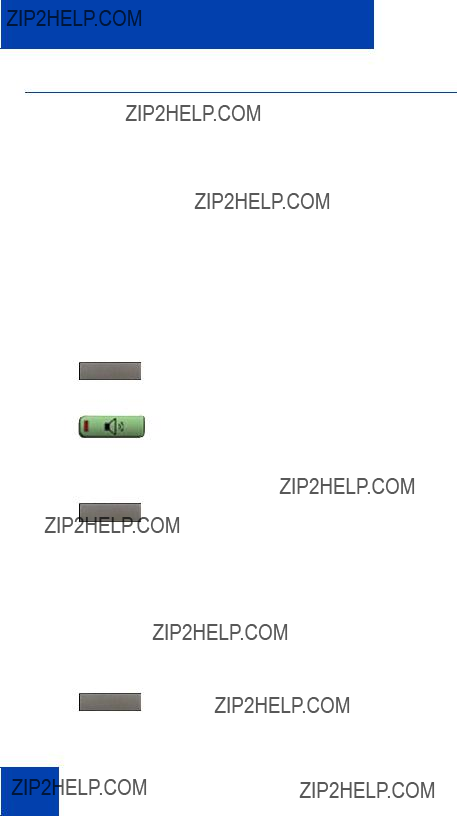
Operating your IP Phone 1210
Managing multiparty calls
Use the following features to enable multiparty conversations:
??????Using Call Join??? on page 88
??????Setting up a Conference Call??? on page 88
??????Using Conferee Selectable Display??? on page 89
??????Using Group Call??? on page 91
Using Call Join
Use the Call Join feature to connect a new caller to an active call. This connection creates a conference (conversation involving more than two parties) between the two callers and yourself.
Conf
Conf
1.To connect a call on hold to your current call, press the Conf soft key.
2.Press the Handsfree key to connect the caller to your current call.
3.Press the Conf soft key again to join the person on hold to your conversation.
Setting up a Conference Call
Use the Conference feature to initiate a conference call for a group of three to six people including yourself. The maximum number of people supported in a conference call depends on the IP Phone configuration.
88
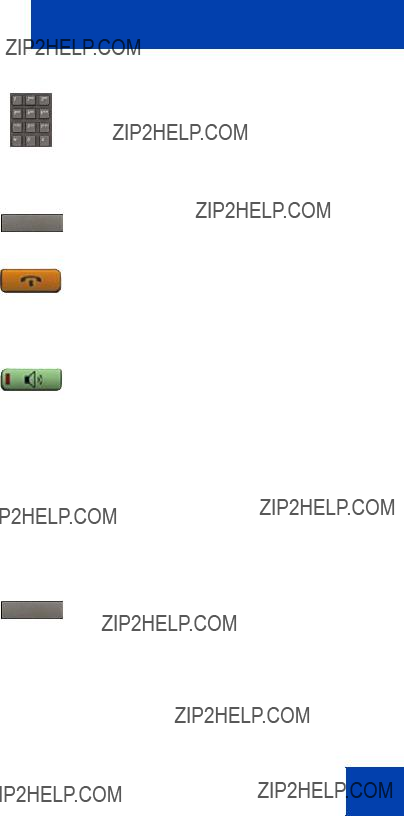
Operating your IP Phone 1210
Conf
(Goodbye)
2.Dial the number of the person to add to the conference call.
You can talk to the person without intervention from the party on hold.
3.Press the Conference key again to connect all parties.
4.If the party you attempt to add to the conference is unavailable, press the
Goodbye key. The call ends.
5.Press the Handsfree key to return to your original call.
Using Conferee Selectable Display
Use the Conferee Selectable Display feature to list active conferees and to disconnect a conferee from the conference call.
Viewing active conferees
Use the following procedure to view active conferees.
89
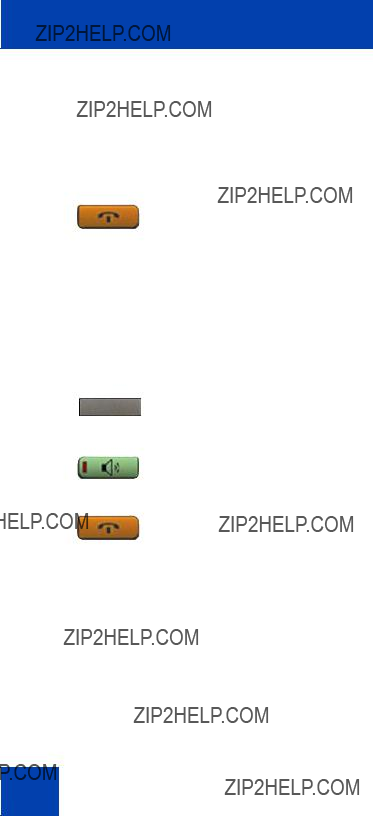
Operating your IP Phone 1210
Disconnecting a conferee
Use the following procedure to disconnect a conferee.
ConfDsp
(Goodbye)
1.During a conference call, press the Confdsp soft key until the conferee to disconnect appears on the screen.
Press the Handsfree button to disconnect the conferee.
2.For a single conferee, press the Goodbye key. If configured, the
Conference Count Display returns an updated total count of conferees. The LCD indicator turns off.
or
For multiple conferees, repeat steps 1 and 2 until all conferees are disconnected. Then press the Goodbye key.
90
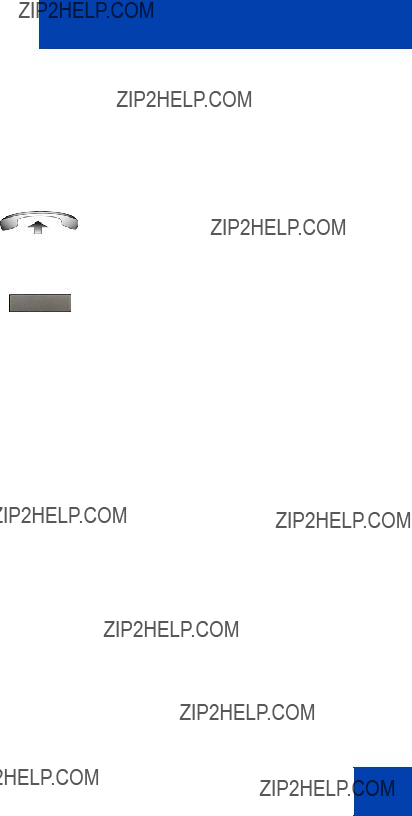
Operating your IP Phone 1210
Using Group Call
Use the Group Call feature to automatically call members of a predefined group, one at a time, until all members answer.
Calling group members
Use the following procedure to call group members.
The feature automatically calls all group members. The icon flashes until all members answer. The phone numbers of the group members appear on the display as they answer. When the last person answers, the Group Call icon lights steadily.
Note: When a person in your group is on a conference call or another group call, they are not connected to your group call.
Note: During a group call, only the person who initiated the group call can put the call on hold.
91
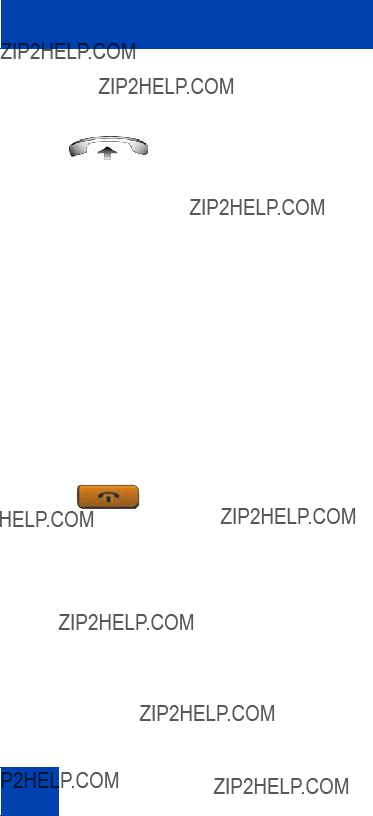
Operating your IP Phone 1210
Answering a group call
Use the following procedure to answer a group call.
1.Lift the handset.
Note the following about notification tones:
???If you are on a call and receive three
???If you are on a call on another line when a group call is made, you receive a long tone through the handset or speaker.
???If you are already on a conference call or another group call, you do not receive notification of a group call.
Ending a group call
Use the following procedure to end a group call.
92

Operating your IP Phone 1210
Managing calls while busy at work
Using Make Set Busy
Use the Make Set Busy feature to make your IP Phone appear busy to all callers.
Activating Make Set Busy
Use the following procedure to activate Make Set Busy.
Deactivating Make Set Busy
Use the following procedure to deactivate Make Set Busy.
93
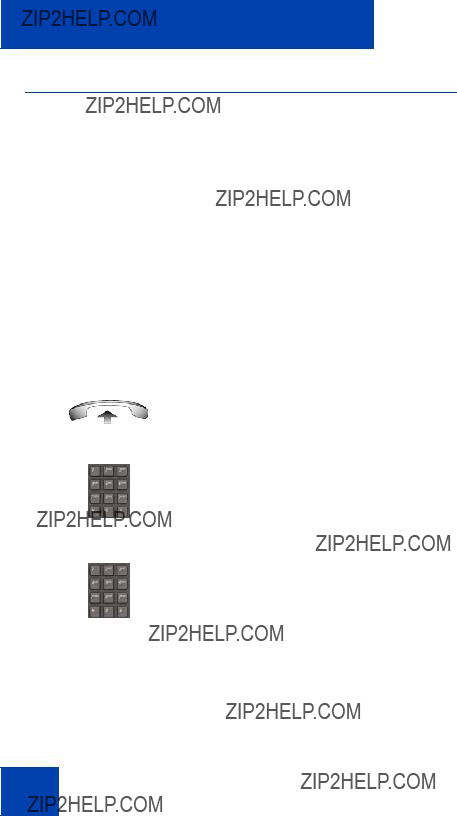
Operating your IP Phone 1210
Hotel ppplications
Hotel applications are a group of hospitality features that increase the value of the IP Phone 1210. In a hotel environment guests can access the following service:
??????Configuring Automatic
Configuring Automatic
Use the Automatic
Entering Automatic
Use the following procedure to enter Automatic
1. Lift the handset.
2.Dial the Automatic
FFC.
3.Dial the Automatic
You hear a tone to confirm your entered time.
To enter the time in a
94

Operating your IP Phone 1210
4. Press the Goodbye key.
(Goodbye)
Cancelling Automatic
Use the following procedure to cancel Automatic
1. Lift the handset.
2. Dial the Automatic
3. Press the Goodbye key.
(Goodbye)
Verifying Automatic
Use the following procedure to verify Automatic
1. Lift the handset.
2.Dial the Automatic
FFC.
95

Operating your IP Phone 1210
3.Dial the Automatic
You hear a confirmation tone if your query matches the preset time.
To enter the time in a
4. Press the Goodbye key.
(Goodbye)
Paging features
The IP Phone 1210 supports the following paging voice call features:
??????Using Call Page Connect to make an announcement??? on page 96
??????Using Radio Page??? on page 97
Using Call Page Connect to make an announcement
Use the Call Page Connect feature to make an announcement over a paging system.
Note: A Page key on an attendant console overrides and disconnects the IP Phones. The IP Phones must reaccess the page trunk.
1. Lift the handset.
96
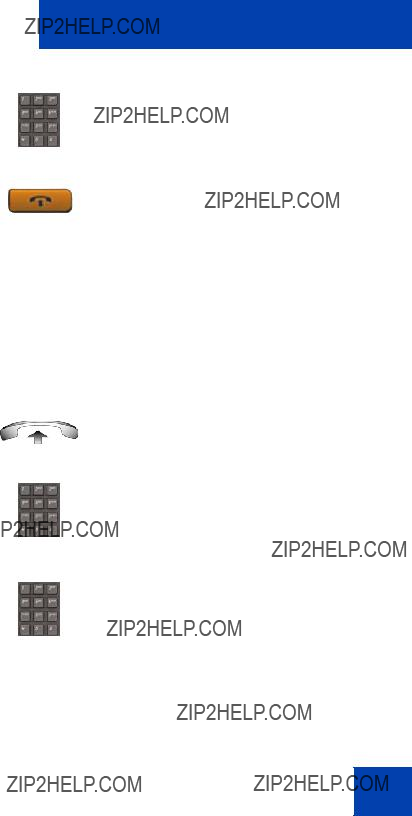
Operating your IP Phone 1210
2.Dial the Page Trunk Access Code to complete the connection to the page system.
3.Make your announcement.
4. Press the Goodbye key.
(Goodbye)
Using Radio Page
Use the Radio Page feature to page a user and stay on the line until the called party answers. The paged user answers the call after entering a special Page
Using Automatic Preselection
Perform the following procedure to use Automatic Preselection.
1. Lift the handset.
2.Dial the Radio Paging Access FFC.
You hear the paging tone (two beeps followed by a dial tone).
3.Dial the number of the party you want to page.
After dialing, you hear the ringback tone.
The paged party can use any IP Phone to enter a Radio Paging Answer FFC and their own DN number.
97

Operating your IP Phone 1210
(Goodbye)
or
4.If your call remains unanswered for a preset time period, during which you hear a
Using Automatic
The called party is either busy on the IP Phone or away from their desk. To page the called party, you need not redial the number of the called party.
98

Operating your IP Phone 1210
Answering a Radio Page
If you carry a Radio Pager, a page indicates that a caller tried to reach you by dialing your DN. If the Radio Page system is configured to function in
1. Lift the handset.
2.Dial the Radio Page Answer FFC. You hear the paging tone.
3.Dial your own DN to connect to the paging caller.
If the caller disconnects, you hear a steadily lit
Miscellaneous Call Features
Some call features are available only if your system administrator configures them. Contact your system administrator to determine if the following call features are available.
??????Charging a call or charging a forced call??? on page 99
??????Using Privacy Release??? on page 103
Charging a call or charging a forced call
Use the Call Charge feature to charge a call to a specific account. The Forced Charge feature charges
99
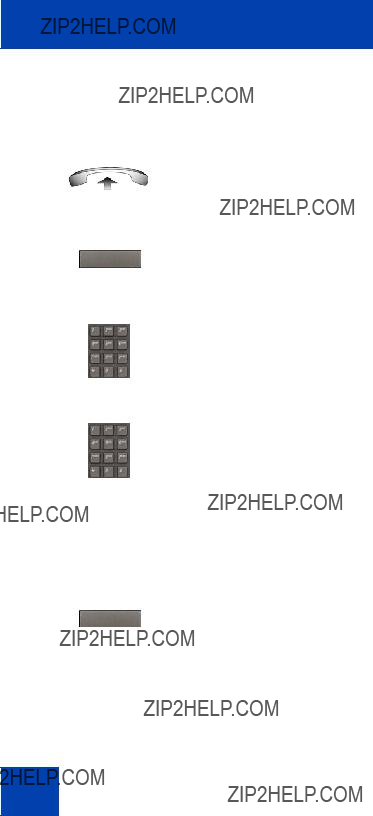
Operating your IP Phone 1210
Charging a local or
Use the following procedure to charge a local or
Charging a transferred call to an account
Use the following procedure to charge a transferred call to an account.
100

Operating your IP Phone 1210
Charge
or
Trans
2. Press the Charge soft key. or
Dial the Call Detail Recording FFC.
3.Dial the charge account number.
4.After you hear the dial tone, dial the number to which you are transferring the call.
5.Press the Transfer soft key when you hear the IP Phone ring.
You can talk privately to the person at the transfer number before you press the
Transfer soft key.
Charging a conference call to an account
Use the following procedure to charge a call to an account when you add someone to a conference call
101

Operating your IP Phone 1210
3.Dial the charge account number.
4.Dial the number of the person you want to add to the conference.
102

Operating your IP Phone 1210
Using Privacy Release
Use the Privacy Release feature to enable one or more people who share your DN to join a call.
Using External Server Applications
Use External Server Applications to directly access a variety of applications from your IP Phone 1210.
To learn more about the available features and services, contact your system administrator. Depending on which features are available on your system, your phone can provide information; for example, local news and weather, stock market information, or traffic reports.
For more information about the External Server Applications, see the
Nortel IP Phone External Server Applications User Guide
103

Troubleshooting your IP Phone 1210
Troubleshooting your
IP Phone 1210
This section provides basic information about troubleshooting your
IP Phone 1210 if Virtual Office causes a problem. For additional help, see ???How to get help??? on page 20.
Virtual Office
Table 10 lists error messages and describes actions to correct the causes.
Table 10: Troubleshooting Virtual Office (Part 1 of 4)
104

Troubleshooting your IP Phone 1210
Table 10: Troubleshooting Virtual Office (Part 2 of 4)
105

Troubleshooting your IP Phone 1210
Table 10: Troubleshooting Virtual Office (Part 3 of 4)
106

Troubleshooting your IP Phone 1210
Table 10: Troubleshooting Virtual Office (Part 4 of 4)
Flexible Feature Codes
Use Table 11 to track and organize the FFCs assigned to features by your system administrator.
107

Troubleshooting your IP Phone 1210
108

Terms you should know
Terms you should know
Calling Party Name Display
Information appearing on the LCD display screen, such as the caller???s name and phone number. The system must have CPND enabled.
Category 5 (Cat5)
Cable and associated connecting hardware capable of transmitting at speeds up to 100 MHz, used by 10BaseT, 100BaseT4, 100BaseTX.
Category 5e (Cat5e)
Most Cat5 cable manufactured after 1996 also supports 1000BaseT (GigE) installations, and is designated Cat 5e. Cat5e cable normally has four pairs of copper wire.
Category 6 (Cat6)
Cable and associated connecting hardware capable of transmitting at speeds up to 200 MHz. Designed specifically to support 1000BaseT (GigE), it is also compatible with 10BaseT, 100BaseT4, and 100BaseTX installations. The cable normally has four pairs of copper wire.
Communication Server 1000
Your office communication system.
Date/time display
The current date and time when the IP Phone is in an idle state.
Directory Number (DN)
A number consisting of one to seven digits for an IP Phone, and also known as an extension number.
109

Terms you should know
Feature display
An area that shows status information about the feature in use. It also displays the name and status of the active session.
Feature Status Lamp indicator
An LCD or an LED that indicates a data message, contact, or feature status by a flash, wink, steady on, or off.
Fixed key
The
Flexible Feature Codes (FFCs)
Specialized codes entered using the dialpad that enable features (for example, Ring Again).
Goodbye key
A fixed key used to end an active call.
Indicator
An LCD or an LED that indicates the status of a feature by the flash, wink, steady on, or off.
Information display
Any display of call activity, lists, prompts, and status of calls. If the text message exceeds the available display area, a scroll arrow icon indicates that you must use the scroll keys to view the remaining text.
Interrupted dial tone
A broken or pulsed dial tone that sounds when you access some features on your IP Phone.
Message/Inbox
A fixed key on your IP Phone 1140E that connects to your voice messaging system when the key is pressed.
110

Terms you should know
Navigation keys
Keys used to scroll through menus and lists appearing on the LCD display screen.
Any line selected to make a call or receive a call. The term off- hook is applied whether (a) the end user lifts up the handset, (b) the end user presses a line key, (c) the call is automatically answered at the IP Phone, or (d) a line is automatically selected for an outgoing call.
Paging tone
A special tone (two beeps followed by dial tone) that sounds when you use the Radio Paging feature.
Ringback/ring tone
A sound indicating that a call you have made is ringing at its destination.
Services key
A fixed key used to access options such as Telephone Options, Password Admin, Virtual Office Login, Virtual Office Logout, Test Local Mode, and Resume Normal Mode.
Shared Directory Number
A DN (extension) that is shared by two or more persons.
Special Prefix code (SPRE)
Special codes entered using the dialpad, followed by a
Soft keys
A set of keys programmed by your system administrator. These four keys, directly below the display area, have four
111

Terms you should know
programmable layers. These keys are also used to configure parameters in the Telephone Options menu.
Special dial tone
The three consecutive tones followed by dial tone that you hear when accessing IP Phone features.
Station Control Password (SCPW)
Enables security features on your phone to prevent others from making calls from your IP Phone and to prevent access to protected features (for example, Remote Call Forward).
Status Messages
A message displayed to inform the user of important information. A right arrow appears if more than one Status Message is present. Examples of Status Messages include: Message Waiting, All Lines Forwarded to: 6453, Do Not Disturb On, Ring Again active, and Ringer is OFF.
System or Switch
Your office communication system.
Switchhook
A button on which the handset presses down, disconnecting your call when you replace the handset. The handset (when lifted) releases the switchhook, and you either answer a call or you receive a dial tone to make a call.
User interface
Screen displays that interact with the end user as a result of an action or event.
Visual Alerter/Message Waiting indicator
An LCD or an LED that flashes to indicate that a message is waiting or when the ringer is on.
112

Index
Index
A
Answering a call 73 Applications 26 Automatic
C
Call Detail Recording 102 Call Page Connect 96 Call party information 109 CAT5e 34
Conference 27 Conference call 88 configuring
One Button Page 32 Configuring an Electronic Lock on your IP Phone 51
Configuring the Local Tools Menu 53
D
Date/time display 109 Directory Number 109 disconnect a conferee 90 Display incoming calls 82
Displaying call details 82 DN 109
E
Enabling OnHook Default Path 47 Enabling or disabling Call Timer 46 Enter key 26
Entering and editing text 63 Ethernet ports 10
F
Feature display 110 Fixed key 110
Flexible Feature Code (FFC) 110 Flexible Feature Codes 107
G
H
I
Indicator status 110 Information display 110 Installing your IP Phone 1210 30
113

Index
L
Local Area Network (LAN) 9 Local Diagnostics 57
Local Dialpad Tone 42 Logging off Virtual Office 62 Logging on to Virtual Office 60
M
Managing calls during a call 74
Managing calls while away from your desk 82
Managing calls while busy at work 93
Managing your Station Control Password 50
Meet - me page 97 Message key 110
Message waiting indicator 27, 112 Miscellaneous Call Features 99 More key 25
N
O
One Button Page
P
R
Regulatory and safety information 12
Retrieving a call on hold 75 Ringback/ring tone 111
S
Selecting a language 40 Selecting a local dialpad tone 42 Services key 27, 28, 111 Shared Directory Numbers 111 Soft keys
Special Prefix code (SPRE) 111
Station Control Password (SCPW) 112
Status Messages 112 Switchhook 112
114

Index
U
Using Call Park 79 Using Call Waiting 75
Using Conferee Selectable Display 89
Using Group Call 91 Using Handsfree dialing 66
Using Internal Call Forward 83 Using Last Number Redial 71 Using Make Set Busy 93 Using
Using Remote Call Forward 85 Using Speed Call 71
115

Index
116

Nortel Communication Server 1000
Nortel IP Phone 1210
User Guide
Copyright ??
LEGAL NOTICE
While the information in this document is believed to be accurate and reliable, except as otherwise expressly agreed to in writing NORTEL
PROVIDES THIS DOCUMENT "AS IS" WITHOUT WARRANTY OR CONDITION OF ANY KIND, EITHER EXPRESS OR IMPLIED. The information and/or products described in this document are subject to change without notice.
Nortel, the Nortel logo, the Globemark,
All other trademarks are the property of their respective owners.
Publication Number:
Document Release: Standard 02.03
Date: March 2009
Sourced in Canada, India, and the United States of America
To provide feedback or report a problem in this document, go to www.nortel.com/documentfeedback.
www.nortel.com